Appearance before the Standing Committee on Indigenous and Northern Affairs: Barriers to Indigenous Economic Development, February 11th, 2022
The Honourable Patty Hadju, Minister of Indigenous Services and Christiane Fox, Deputy Minister
Table of contents
- Scenario Note
- Opening Remarks
- Supports for Economic Development Programs
- Supports to businesses during COVID-19
- Indigenous Procurement
- Supports for Housing
- Healthier populations through education
- Healthier populations through health
- Supports for Tourism
Federal Economic Development Agency for Northern Ontario
- Transition to a Standalone Agency
- Regular Programming Supporting Indigenous Economic Development
- Support to Indigenous Organizations and Businesses that Deal with the Impact of COVID-19
- Available Supports to Indigenous Businesses, Organizations and Communities Including COVID-19 Recovery
- Support to Indigenous Procurement Opportunities
- Support to Indigenous Tourism in Northern Ontario
Indigenous Services Canada
Appearance before
Standing Committee on Indigenous and Northern Affairs
Scenario Note
LOGISTICS
Date: Friday, February 11, 2022
Time 1 p.m. to 2 p.m.
Location: Videoconference (Zoom)
Subject: Barriers to Indigenous Economic Development
Witnesses from Indigenous Services Canada
- The Honourable Patty Hajdu, Minister of Indigenous Services and Minister responsible for the Federal Economic Development Agency for Northern Ontario
- Christiane Fox, Deputy Minister
- Christopher Duschenes, Director General, Economic Policy Development, Lands and Economic Development
- Jessica Sultan, Director General, Economic and Business Opportunities, Lands and Economic Development
- Manon Brassard, Interim President, Canadian Economic Development Agency for Northern Ontario
Witnesses from Crown-Indigenous Relations and Northern Affairs Canada
- The Honourable Dan Vandal, Minister of Northern Affairs, Minister responsible for Prairies Economic Development Canada and Minister responsible for the Canadian Northern Economic Development Agency
- Paula Isaak, President of the Canadian Northern Economic Development Agency, and Associate Deputy Minister of Crown-Indigenous Relations and Northern Affairs Canada
- Serge Beaudoin, Assistant Deputy Minister, Northern Affairs
- Mohan Denetto, Director General, Executive Advisor, Prairies Economic Development Canada
Context
INAN adopted the following motion on February 1, 2022 from the Conservative Party of Canada: That the committee undertake the following studies, in the order shown below, allotting a maximum of six meetings for each study:
That, pursuant to Standing Order 108(2), the committee undertake a study on the existing barriers to Indigenous economic development and how to remove them; and, that the committee invite officials from the National Aboriginal Institutions created in the First Nations Fiscal Management Act (2005), officials from the Department of Finance, officials from the Department of Indigenous Services, the Minister of Indigenous Services, officials from the Department of Crown-Indigenous Relations and Northern Affairs, the Minister of Crown- Indigenous Relations, and the Minister of Northern Affairs; that all meetings for this study be televised; that the committee report its findings and recommendations to the House; and that, pursuant to Standing Order 109, the committee request that the government table a comprehensive response to the report.
The committee also adopted other motions to study the restitution of land to Indigenous Peoples, health care rights, and emergency preparedness.
Background on the Study
INAN has held two meetings on the study of Barriers to Indigenous Economic Development. The key issues that were raised by the Conservative members include Government reluctance to give up control to First Nations, financing for First Nations, how the Government can promote the economic freedom of First Nations, and solutions on how to reduce the infrastructure gap. The NDP inquired about the effect of the pandemic on economic development in Indigenous communities, as well as how a lack of housing and drinking water hinders economic development. The Bloc Québécois asked about impediments for Indigenous businesses in remote communities. The Liberals asked if First Nations should be provided with taxation powers that would enable them to improve their economies, how treaties assist with economic development, and how the federal government can help facilitate funding for Indigenous-owned businesses.
Here is a summary of some of the key points raised by the witnesses:
Canadian Council for Aboriginal Business
- We would like to see as a recommendation by this committee is a comprehensive federal government-wide strategy driven by indigenous peoples to support the [Inaudible]. Indigenous entrepreneurship strategy would make indigenous prosperity a priority for every federal department, agency and regulator, and provide the necessary down payment to support economic reconciliation.
- Indigenous entrepreneurship strategy should include the following three key pillars; access to procurement and program opportunities, access to markets and supply chain networks, and access to funding.
- We see eliminating the barriers to federal procurement, in addition to infrastructure set-asides for Indigenous businesses and communities, as critical steps to indigenous economic development.
Métis National Council
- Commit to the re-establishment of the Métis Economic Development Strategy through the capitalization of the Métis Capital Corporations rather than a push to borrow; the Aboriginal Entrepreneurship Program growth supports demonstrated demand; access to the Canada Small Business Financing Program and support in establishing regulated commercial sector Métis institutions.
- Equitable access to current economic development programming. First Nations and Inuit have access to the Lands and Economic Development Services Program; Métis do not, and to Regional Development Agencies
- Co-developed programming to address the gaps. There is no First Nations Finance Authority equivalent for Métis—that should be co-designed; co-designed programming in clean growth infrastructure; access to CMHC insurance and on procurement modernization, the funding of Métis business registries, and a commitment to develop meaningful statistics to guide our joint efforts.
British Columbia Assembly of First Nations
- Barriers include lack of respect for first nations' rights, jurisdictions—as it relates to treaties —and our inherent rights, lack of involvement in economic development planning decisions and financing.
- Finance is always an issue in regard to funding certain projects that are led by First Nations or are in partnership with First Nations. It's very difficult to access financing in terms of getting the necessary financing on many projects out there in terms of infrastructure and/or development of projects that are important to, not only our First Nations communities, but to the economy in general.
National Aboriginal Capital Corporations
- Proposes the creation of a $150-million Indigenous housing fund from which aboriginal financial institutions could leverage financing for individual and community housing.
- Additional funding for the aboriginal entrepreneurship program, announced in budget 2021, must meet the current needs and be made permanent.
- Provide 10-year funding agreements to qualified institutions.
First Nations Finance Authority
- We developed a proposal we call monetization … Monetization would see FNFA issue debentures into capital markets which could be used to fund infrastructure and other economic development (creating) a greater overall impact than the current federal approach. What's missing in the equation is a sufficient revenue stream to cover debt servicing and repayment.
First Nations Financial Management board
- We need to allow the creation of critical mass of communities to achieve the economies of scale that can offer the front and back office capacities required to secure the information needed.
- The need for modern day transfer arrangements between Canada and the provinces and First Nation governments.
- The need to modernize our administrative capacity to respond to the economic and governance matters that communities find themselves having to deal with.
First Nations Tax Commission
- We are proposing a new institution under the First Nations Fiscal Management Act, the First Nations infrastructure institute
- We are proposing an increase in fiscal powers to include fuel, alcohol, cannabis and tobacco taxes.
- We're proposing a First Nations Resource charge in our ancestral lands. Implementing our fiscal powers is the fastest way to end colonial-era dependency.
Context on the Members
Most of the members are new to the Committee with the exception of MP Jamie Schmale (CPC), MP Jaime Battiste (Lib), MP Marcus Powlowski (Lib) and MP Gary Vidal (CPC).
MP Gary Vidal (CPC), critic of Crown-Indigenous Relations, has pressed the Government recently to involve Indigenous softwood lumber producers in the discussions in developing a softwood lumber agreement. "I believe there is an obligation to have many stakeholders at the table to solve the issues facing many Canadians across the country." (Hansard, December 1, 2021)
Martin Shields (CPC), who is critic for Indigenous Services, has not been vocal on Indigenous issues, but during the Federal election, he indicated that he will seek to strengthen existing relationships with Indigenous Nations such as Siksika in Alberta. Shannon Stubbs (CPC) has expressed concerns for the disproportionate challenges Indigenous people face, and indicated that concrete action is needed. (My Lloyd Minister Now, September 3, 2021)
Lori Idlout (NDP), the critic of Crown-Indigenous Relations and Northern Affairs, will likely focus her questions on the economy in Nunavut. During the federal election, she indicated her main priorities were housing and mental health. Recently in the House of Commons, she expressed concerns with the standard of living of people in the territory. "Nunavummiut experience this crisis disproportionately. In 2016, Nunavut food costs were three times the national average. In 2018, 62% of Nunavut's households with children were food insecure. High cost of living affects Nunavummiut's access to their most basic human rights, including food, water, housing, health and mental health. We have felt these challenges for far too long, despite government programs and subsidies aimed at providing relief." (Hansard, January 31, 2022)
MP Marilène Gill (BQ) has been an active participant of INAN over the years. She has posed questions in the past about Indigenous rights, food security in the North, and the lack of progress in the Truth and Reconciliation Commission's Calls to Action. She has recently expressed the need to improve economic development and housing in Indigenous communities in northern Quebec. "The Innu and Naskapi make up 15% of the North Shore's population … We need to take action on the ground. The big issues are economic development and ending violence. The pandemic has hit First Nations harder than most. What they need is housing."
MP Pat Weiler's (Lib) key interests are tourism, labour, housing and affordability. He has indicated that he was "proud" when the United Nations Declaration on the Rights of Indigenous People received Royal Assent on June 21, 2021. (Pique News Magazine, August 27, 2021)
MP Jenica Atwin (Lib) has expressed concerns about racism against Indigenous people, and the problems they face in Indigenous communities with water, housing, and education. "It is imperative to our success and our collective well-being that we confront trauma in Canadian society. The Truth and Reconciliation Commission of Canada educates us about the intergenerational trauma that still ripples through communities today, about underfunded education and child welfare services, and about discrimination. (Hansard, November 30, 2021).
MP Michael Mcleod (Lib) will likely raise issues that pertain to communities in his riding in the Northwest Territories. He has indicated the importance of improving infrastructure. "Earlier today I met with Prime Minister Justin Trudeau to discuss some of the priorities of NWTers, including Indigenous rights and closing the infrastructure gap." (Twitter, December 15, 2021)
MP Jamie Battiste (Lib), who is also the Parliamentary Secretary to the Minister of Crown-Indigenous Relations, often speaks to first-hand experience, and issues that affect Indigenous people in his riding in Nova Scotia (Sydney-Victoria). He's also indicated his concerns with ensuring efforts are being made to advance self-determination to improve economic development. "Lands are a crucial asset for advancing self-determination, economic development and well-being. Additions to reserve play a significant role in returning land to Indigenous communities, fulfilling legal obligations, improving relationships with Indigenous communities, and fostering economic opportunities." (Hansard, January 31, 2022).
Meeting Proceedings
The meeting is scheduled to occur from 1 p.m. to 2 p.m. on February 11, 2022 via the web platform Zoom.
All witnesses will be asked to connect to the meeting at 12:30 p.m. The Zoom link will be sent directly from the House of Commons to the witnesses.
The Chair will open the meeting and provide instructions for the meeting proceedings. He will then introduce all witnesses. It is recommended to speak slowly and at an appropriate level to ensure the interpreters can hear you. All witnesses are requested to mute your microphone when you are not speaking.
While simultaneous translation will be available, witnesses are asked to respond to questions in either language but to limit switching back and forth between languages as this often creates technology/interpretation challenges. It is recommended to deliver the speech in one official language.
Following the opening remarks, there will be rounds of questions from Committee members (as listed below).
1. Committee members will pose their questions in the following order:
- First round (6 minutes for each Party)
- Conservative Party of Canada
- Liberal Party of Canada
- Bloc Québécois
- New Democratic Party of Canada
- Second round
- Conservative Party of Canada (5 minutes)
- Liberal Party of Canada (5 minutes)
- Bloc Québécois (2.5 minutes)
- New Democratic Party of Canada (2.5 minutes)
- Conservative Party of Canada (5 minutes)
- Liberal Party of Canada (5 minutes)
The meeting can be watched via Parlvu, however there is a 70-second delay.
Opening Remarks
Speech for Minister Patty Hajdu Minister of Indigenous Services Canada
For appearance at the Standing Committee on Indigenous and Northern Affairs
Topic: Barriers to Indigenous Economic Development
February 11, 2022
Check on delivery
Thank you very much, Mr. Chair and members of the committee. This is my first appearance before the committee, and I'm honoured to be here with you.
I'm joining you today from the Robinson-Superior Treaty territory, specifically Fort William First Nation traditional territory. Of course, many contributions were made to this area over generations by Métis people.
One of this government's highest priorities from the outset has been to build a renewed relationship with indigenous peoples in Canada. I'm continuing to build that relationship. I'm prioritizing equity, truth and self-determination as principles that are integral to a strong and healthy relationship.
Indigenous Services Canada works collaboratively with first nations, Inuit and Métis partners across the country. Our goal is to ensure a consistent, high quality and distinctions based approach to the delivery of services to indigenous communities.
At the heart of our work is the steadfast belief in substantive equality of opportunity and in outcomes. Canada will be stronger when everyone has a fair chance to succeed, and this includes advancing self-determination through strong economic growth and ensuring that business supports are accessible to indigenous peoples.
All communities need a strong economic foundation to grow and prosper, but we recognize that there are extra barriers to indigenous economic development. I'll talk about some of those barriers here today and ways to overcome them because, to work together on solutions, we actually have to understand what the problems are.
What are these barriers? First of all, lack of access to capital is one of the biggest challenges faced by indigenous businesses and can prevent indigenous entrepreneurs from starting or growing businesses.
To improve access to capital, the National Aboriginal Capital Corporations Association administers the aboriginal entrepreneurship program, which provides about $25 million per year of equity capital to enable indigenous entrepreneurs to obtain affordable commercial loans. The aboriginal entrepreneurship program is also supporting the new $150-million indigenous growth fund. This indigenous-led and designed fund is a key economic recovery initiative, which will provide indigenous businesses with a fully independent source of capital.
Indigenous businesses continue to experience negative impacts due to COVID-19 on top of the barriers they already faced before the pandemic began. While the Canadian Council for Aboriginal Business reported last week that the situation is improving, many indigenous businesses continue to have negative impacts.
To fill gaps in the mainstream COVID-19 economic recovery initiatives, our department has provided indigenous businesses with targeted supports throughout the pandemic. To date, Indigenous Services Canada has allocated approximately $890 million in COVID-19 supports to indigenous businesses. This is on top of its regular programming to support economic development and other Government of Canada supports that can be accessed by indigenous businesses through the COVID-19 economic response plan.
One of its COVID-19 business supports is the indigenous community business fund, which provides support to eligible first nations, Inuit and Métis businesses whose revenues have been affected by the pandemic.
In British Columbia, the fund has provided over $2 million of much-needed emergency support to the St. Eugene Golf Resort & Casino, which is owned by five first nations and is located in Cranbrook. This business is a major tourism anchor in the region and employs over 200 people, including many first nations members. Support from the fund helped to cover the fixed operating costs as well as support costs needed to adapt to COVID and to maintain its assets.
The hotel is now preparing to reopen this spring, and although the tourism sector is still in recovery, funding from the indigenous community business fund has helped support this community-owned business and helped the communities retain jobs.
As I'm also the minister responsible for the Federal Economic Development Agency for Northern Ontario, it's very important to me that the regional relief and recovery fund continue to help indigenous businesses and organizations mitigate the impacts and recover from the COVID-19 pandemic. FedNor has played a critical role in providing meaningful support to indigenous clients in their ongoing planning, community economic development and capacity-building efforts.
Indigenous Services Canada has also made investments to help indigenous communities offset own-source revenue losses due to the pandemic. The own-source revenue and indigenous communities initiative has helped to partially offset declines in own-source revenues so that first nations, Inuit and Métis communities can continue to provide core community programs and important services to their members.
Our department has also been very active in working to reduce barriers faced by indigenous businesses when it comes to participating in federal procurement. In August, 2021 we updated the procurement strategy for indigenous businesses and announced a new government-wide mandatory procurement target to ensure that a minimum of 5% of the value of federal contracts are awarded to businesses owned and led by indigenous individuals.
We will continue to work with indigenous partners to develop a longer-term transformative approach to indigenous procurement.
Businesses established in the indigenous community may also face a lack of access to land and proper infrastructure. Indigenous entrepreneurs may have trouble finding physical space to conduct their business and accessing business networks. In addition, they may have unreliable access to electricity and Internet connections. Lastly, they may face challenges in getting goods to market given the remoteness and poor or unavailable road infrastructure. These are complex issues.
Our government is working closely with indigenous people and organizations across the country to address the root causes of these barriers and to improve overall economic networks.
Supports for Economic Development Programs
| Name of Program | Aboriginal Entrepreneurship Program (AEP) | Lands and Economic Development Services Program (LEDSP) | Community Opportunity Readiness Program (CORP) | Strategic Partnership Initiative (SPI) | First Nations Land Management (FNLM) | Reserve Land and Environment Management Program (RLEMP) |
|---|---|---|---|---|---|---|
| Holder of Program |
|
ISC | ISC | ISC | ||
| Purpose | To support small and medium-sized Indigenous businesses commercial lending activities (to keep loans affordable for borrowers and lenders). | The Lands and Economic Development Services Program (LEDSP) provides support to First Nation and Inuit Communities to assist with enhancing the economic development, land and environmental capacity of communities and to support the establishment of the conditions for economic development to occur, increasing their participation in the economy. | The Community Opportunities Readiness Program (CORP) provides project-based funding for First Nation and Inuit Communities for a range of activities to support communities' pursuit of economic opportunities. Where First Nation and Inuit communities, or their representative organizations, identify opportunities and lack the financial resources to pursue them, the CORP will allow them to submit proposals to seek additional funding. | The Strategic Partnerships Initiative (SPI) is a whole-of-government mechanism housed at ISC, which works to increase and support Indigenous participation (First Nations, Metis and Inuit) in large, complex, multi-year economic development opportunities that span a range of sectors. | First Nations transition away from the application of 44 lands-related sections of the Indian Act and instead operate under a community-developed and approved Land Code, enabling movement at the speed of business, and supporting First Nations in taking advantage of valuable resources and economic potential in a manner grounded in self-determination. To date, 99 First Nations have re-claimed land governance through First Nations Land Management and are operating under land code, and 62 more First Nations are actively working to develop their land codes. | Enables First Nations to assume greater control over reserve land, resources and environment on behalf of the Minister and pursuant to the Indian Act. To date, 130 First Nations are participating in the program. |
| Approach / Structure |
|
LEDSP Core Allocations, include:
|
Proposal-based financial support to First Nation and Inuit Communities to assist in their pursuit of, and participation in, economic opportunities. Indigenous Services Canada (ISC) assesses proposals based on their immediate or future ability to attract private sector funding and on their community economic impacts, and supports projects that will leverage the most from other funding sources, including the private sector, and that will have the greatest impact on their community. |
SPI's horizontal Terms and Conditions can be used to flow funding to all Indigenous (First Nations, Inuit, and Métis) recipients, even where existing program authorities may not be available to all Indigenous groups. That said, SPI is not divided or allocated on a distinctions or rights basis, though the flexibility of the Program means that an Initiative could be specifically targeted towards a specific Indigenous group. | Supports, through the First Nation Land Management Resource Centre, First Nations develop and seek community-approval of land codes. Once a community's land code is approved, operational funding is provided directly to communities as a contribution to their management of their reserve lands and environment. |
Supports training of land managers through the Professional Land Manager Certification program, and the National Aboriginal Land Managers Association (NALMA). Provides direct support to communities to undertake land management activities under the Indian Act. |
| Partners | The National Aboriginal Capital Corporations Association (NACCA 54 Aboriginal Financial Institutions (AFIs) 5 Métis Capital Corporations (MCCs) The soon-to-be-launched Association of Métis Capital Corporations (AMCC) The Inuit Tapiriit Kanatami is working with ISC to complete distinctions-based delivery |
Regional Offices | Regional Offices | Agriculture and Agri-Food Canada Atlantic Canada Opportunity Agency Canada Economic Development for Québec Regions |
Lands Advisory Board (LAB) First Nations Land Management Resource Centre |
National Aboriginal Lands Managers Association Tulo Centre of Indigenous Economics |
| Funds: Amount and Status |
|
|
|
For every dollar of SPI funding, the Initiative has leveraged approximately $4 of additional funding from other sources – nearly $500M from other federal government departments, provincial and territorial governments, as well as private industry. | Budget 2021-22: $66.4M First Nations fall under 1 of 4 categories, determined by population, reserve size and # transactions in ILRS, compliance, environment, LUP. |
Budget 2021-22: $18.4M The formula is based on: Population, reserve size and number of land instruments registered in the ILRS. |
| Budget announcement(s) | B2019
B2021
|
A-based program | A-based program; additional $15.8 M provided in B2019 for national portion of program | B2021 |
Budget 2018 - $143M over 5 years for the expansion of First Nation Land Management | |
| Clientele | Small and medium-sized Indigenous businesses (First Nations, status and non-status operating on and off-reserve, Métis and Inuit entrepreneurs) | First Nation and Inuit communities south of 60 (those in the territories are eligible for services through CANNOR) | First Nation and Inuit communities south of 60 (those in the territories are eligible for services through CANNOR) | Coordinating partners involved in complex economic development opportunities that benefit Indigenous communities (First Nation, Inuit, and Métis) | First Nations communities with reserve land who wish to reclaim jurisdiction over their lands. | First Nations communities with reserve land operating under the Indian Act. |
| Transfer of Services | Administration of the AEP was transferred from ISC to NACCA in 2015. In 2019-20, MCCs began to administer two components of the program for themselves. ISC is working with the Inuit Tapiriit Kanatami to address the priorities of Inuit entrepreneurs |
Eligible for transfer to Indigenous organizations | Eligible for transfer to Indigenous organizations | Not considered for devolution, however SPI can be used to support initiatives that facilitate transfer | The FNLMRC has taken on progressively more responsibilities with respect to the intake and support for developmental communities, as well as the delivery of project-based funding. Program management of the land use planning initiative for FNLM First Nations was transferred to the FNLMRC. |
Program management of the Land Use Planning Initiative, survey project funding and the Professional Land Management Certification Program (PLMCP) were transferred to the National Aboriginal Lands Managers Association. |
Examples of business successes through ISC Economic Development Programs
Aboriginal Entrepreneurship program (AEP)
Jacob & Samuel Drilling Ltd. - Shannon Bennett, Sudbury, Ontario
Jacob & Samuel drilling (established in 2012) specializes in mineral extraction and extracting cores for
mining companies using diamond-bit drills. Its focus is extracting the best cores in the most costeffective
means. It has been financed by both the Métis Voyager Development Fund and Waubetek
Business Development Corporation. Shannon Bennett says, "the Métis Voyager Development Fund
were unbelievable. …they set aside time to help us do business plans and promotional material. They
did a lot of the heavy lifting. And Waubetek Business Development Corporation assisted me with
grants for my backdrops, and my promo stuff, which is really important for growth."Shannon-Bennett-Bio. (PDF Version, 115.16 KB, 1 page) and Jacob Samuel Drilling
Ltd.
McKenn Contracting - Ken Atcheynum, Battlefords, Saskatchewan
Ken Atcheynum is a youth entrepreneur and a member of Sweetgrass First Nation in the Battlefords
area of Saskatchewan. Ken worked alongside his father in the construction industry but had ambitions
of starting his own business.
"In 2009, Ken purchased a grader and officially started his own business. Today, McKenn Contracting offers landscaping, water/sewer, basements and residential/commercial construction services." "Ken pointed out that the Saskatchewan Indian Equity Foundation played a critical role in start-up financing of his business dream and advisory services in planning and expansion. While McKenn Contracting now operates a number of heavy equipment, Ken still has plans to grow and expand his business in order to take on larger projects into the future." Client-Ken-Atcheynum-Poster-Poster (PDF Version, 351.49 KB, 1 page)
CORP (Community Opportunities Readiness Program)
Tk'emlups te Secwepemc Road Realignment and Roundabout Project
- $1,514,496 to support commercial leasing opportunities on reserve for Tk'emlups te Secwepemc through the creation of a roundabout and road realignment and infrastructure services.
Samson Cree Nation Menaik Industrial Park
- $2,239,931 to support the construction of the Menaik Industrial Park by the Samson Cree Nation.
Membertou First Nation - Membertou Green Diamond Expansion
- $977,549 to support Membertou First Nation to expand its realty business, Membertou Properties Limited, with site preparation and building located in the Seventh Exchange Development.
Eel Ground Commercial Fisheries Expansion
- $1,000,000 to support Eel Ground First Nation to expand its commercial fisheries operation with the purchase of a snow crab license and fishing equipment.
Millbrook First Nation, Madawaska Malaseet First Nation and Membertou First Nation
- $1,000,000 to support Millbrook Cole Harbour Apartment Expansion to construct a new apartment complex at the Cole Harbour reserve.
LEDSP (Lands and Economic Development Services Program)
Cando - Council for the Advancement of Native Development Officers ($768,500 over 3 Years 20-23) Cando continues to build capacity in key core functional areas that strengthen Indigenous economies by providing programs and services to Economic Development Officers (EDOs) working in Indigenous community economic development through the following programs: Certification, Education & Training, Scholarships, EDO Educational Tools & Communication, Networking, Special Projects.
CEDI – Community Economic Development Initiative Phase III ($2,880,000 over 4 years) Administered through Cando, CEDI is a national program bringing together First Nations, tribal councils, municipal and regional governments, community economic development corporations and other organizations to collaborate on joint-led, long-term land use and economic development planning.
SPI (Strategic Partnership Initiative)
The Strategic Partnerships Initiative (SPI) is organized around initiatives that are focused on specific complex economic development opportunity, that is often sectoral/regional. Key initiatives include but are not limited to the following below:
The Forest Full Value Initiative
A SPI co-administered initiative launched in 2018 over a period of four fiscal years, that is led by
Indigenous Services Canada and Natural Resources Canada. The initiative is aimed at the economic
development of Indigenous communities generated by the conversion of forest resources into valueadded
products and services such as biofuels, biofertilizers, biotextiles and non-timber forest
products (NTFPs). The Forest Full Value Initiative relies on the collaboration between traditional and
scientific knowledge and wishes to establish an innovative and inclusive governance (active
participation of First Nations). It mainly involves 7 Aboriginal communities in Quebec, grouped by
three (3) different projects that provide opportunities. Approximately $3.65M of SPI funding was
allocated to the Forest Full Value Initiative: $805,000 for 2018-2019; $980,000 for 2019-2020;
$970,000 for 2020-2021; and $895,000 for 2021-2022.
British Columbia Indigenous Clean Energy Initiative (BCICEI)
SPI's BCICEI is an initiative launched in 2016, and is co-led by PacifiCan and ISC British Columbia
region. Over time, it evolved to include a wide array of other key partners - including the province of
British Columbia, BC Hydro, as well as the New Relationship Trust (an Indigenous organization). The
initiative provides early support to develop Indigenous communities' capacity and readiness to
advance local clean energy projects in Indigenous communities throughout BC. To date, the BC
Indigenous Clean Energy Initiative has demonstrated significant economic and environmental benefits including: funding 45 First Nation communities; supporting 56 clean energy projects; engaging 100 Indigenous communities; 1089 jobs created; 609 individuals trained; and a 2,216,321 L annual diesel
reduction. Approximately $8.9M of SPI funding was allocated to BCICEI.
Supports to businesses during COVID-19
| Name of Program | COVID-19 Indigenous Business Initiative (COVID-IBI) $306.8 million |
Indigenous Community Business Fund (ICBF) $234 million (2 announcements of $117M) |
Own-Source Revenue in Indigenous Communities Initiative (OSRICI) $332.8 million |
|---|---|---|---|
| Purpose | To support small and medium-sized Indigenous businesses in mitigating the negative impacts of the COVID-19 pandemic on their businesses. |
To support Indigenous communities and businesses affected by the COVID-19 pandemic who do not qualify for other federal support measures. | To partially offset declines in own-source revenues due to COVID-19 in order to help First Nations, Inuit, and Métis communities continue to provide core community programs and services. |
| Approach/ Structure |
|
|
$332.8 million in funding to partially offset declines in own-source revenues to First Nations, Inuit and Métis communities. The program is application-based and is open to Indigenous communities that experienced an own-source revenue decline in 2020-2021 because of the COVID-19 pandemic restrictions. |
| Partners |
|
|
|
| Funds: Amount and Status |
$306.8 million in 5 streams:
|
|
|
| Update of Availability of Funding | As of June 30, 2021 the COVID-IBI halted with $20.9 million in interest-free loans and non-repayable contribution (Stream 1 and 2) remaining at ISC. Aboriginal Financial institutions (AFIs) and MCCs have issues $188.1 million to 39XX businesses (which represents 6090 loans). Out of,3 658 business that receive COVID-IBI relief, 1,111 were Women majority-owned businesses. The Contingency Fund (Stream 4) covers capital and interest losses incurred by NACCA and the MCCs on loans made prior to the pandemic. ISC has issued to lender $24 million since the beginning of the pandemic in 2020. The Contingency Funds has a balance of $14 million remaining and is still open until March 31st, 2022 |
|
|
| Clientele | Small and medium-sized Indigenous businesses (First Nations, status and non-status operating on and off-reserve, Métis and Inuit entrepreneurs) | First Nations, Inuit or Métis communities for Stream 1 or First Nations, Inuit or Métis collectively-owned for Stream 2 that have been declined by or do not qualify for other federal business supports. | First Nations, Inuit or Métis communities, self-governing and Modern Treaty First Nations, tribal councils and community governments that have experience declines in own source revenue as a result of the COVID-19 pandemic. |
| Transfer of Services | Not considered for transfer of services | Not considered for transfer of services | Not considered for transfer of services |
Indigenous Procurement
Introduction
- In 2016, Public Services and Procurement Canada and Treasury Board of Canada Secretariat launched a procurement modernization initiative, including a review of the federal approach to Indigenous participation in federal procurement and undertaking broad external consultations and engagements.
- In 2018, ISC and Public Services and Procurement Services Canada signed and sent letters to the 62 core federal organizations suggesting they set a voluntary Indigenous procurement target over five years.
- In December 2019 and 2021, via Ministerial Mandate Letters, Public Services and Procurement Canada was given the operational lead to implement a minimum of 5% Government of Canada Indigenous procurement target with the assistance of ISC and Treasury Board of Canada Secretariat.
- The three departments collaborate with other key federal departments and Indigenous partners to implement the minimum mandatory target and refine policy and program elements.
- The Indigenous Reference Group (IRG), established in early 2020, provides advice on possible changes to the Procurement Strategy for Indigenous Businesses (PSIB) and to collaborate on refining policy elements.
Background
- Work began in 2016 to modernize procurement and increase Indigenous participation in federal procurement, with 60% of all departments and agencies committed to achieving the mandatory minimum 5% target by the end of fiscal year of 2022-23.
- To support this work, the Indigenous Reference Group (IRG) was established in early 2020 to continue engagements with key Indigenous partners.
- In 2021, the Government of Canada announced forthcoming changes to the Procurement Strategy for Indigenous Businesses (PSIB) and the broadening of the Indigenous business definition.
- Mandate Letters from the Prime Minister to the Minister of Public Services and Procurement Canada, includes a commitment to: "… work with the Minister of Indigenous Services Canada and the President of the Treasury Board to create more opportunities for Indigenous businesses to succeed and grow by creating a new target to have at least 5 per cent of federal contracts awarded to businesses managed and led by Indigenous Peoples."
- ISC, PSPC, and TBS, have been granted cabinet authority to modernize PSIB, in place since 1996, and introduce a phased in, mandatory minimum target of 5% of federal contracts to be awarded to Indigenous owned businesses by 2024.
- In 2022, ISC sent correspondence to 94 organizations under schedules I, I.1 and II of the Financial Administration Act to request their Indigenous procurement plans and to confirm departmental phasing.
- In 2020, data sets indicated that Indigenous procurement is currently approximately 2% of the total government spend.
- Expectations have been created with Indigenous partners regarding the codevelopment of the transformative Indigenous procurement strategy. The IRG has voiced concerns that some work has been done without their involvement. It was agreed to meet more regularly and for IRG to participate on Tiger Teams and DGlevel Working Group on the Implementation of the 5%.
- The Government of Canada will continue to engage with Indigenous businesses, Indigenous economic development organizations and their members, Modern Treaty and Self-Governing Organization rights-holders, provincial and municipal governments, corporate Canada and international partners in Indigenous procurement, through existing bilateral and multilateral tables.
- ISC and PSPC are supporting TBS in drafting a Mandatory Procedures document and an accompanying guiding document to support departments and agencies in their efforts to comply with this new government-wide minimum target.
- In parallel, ISC is preparing a second round of engagement and consultations to further modernize Indigenous procurement and work towards the transfer of certain services to an Indigenous-led organization.
Doubling the List of Indigenous Businesses
- The Indigenous Business Directory (IBD) is designed to assist and support Indigenous businesses in the pursuit of business opportunities, including federal procurement. This directory is a resource available to all levels of government, as well as the private sector to identify Indigenous businesses.
- Having a business profile in the directory increases visibility and can also allow businesses to compete for federal government contracts that are set-aside for Indigenous businesses through the Procurement Strategy for Indigenous Business (PSIB) as the Government of Canada's policy support to Indigenous businesses for procurement opportunities.
- The number of Indigenous business in the IBD increased from 1,609 business in 2018 to 2,441 today. It is an increase of over 50% within four years.
- It is anticipated that the number of firms will continue to grow with the changes to
the PSIB and the five per cent Indigenous mandatory procurement target for the
Government of Canada such as:
- Changes to definitions of Indigenous firms to make it easier to meet the criteria;
- Increased outreach and awareness internal to Government of Canada procurement community that the Indigenous firms must be registered in the Indigenous Business Directory prior to contract award;
- Increased outreach and awareness with Indigenous firms, partners and economic development organizations;
- Increased resources for ISC to register firms;
- Funding the development of strategies with Indigenous partners to meet areas of government procurement that lack Indigenous business capacity; and,
- Developing a new communications plan and developing new products to increase awareness.
Coaching Pilot – The Aircrew Training Program
- The Aircrew Training Program has the following mandate:
- To develop an aircrew training program for Pilots, Air Combat Systems Officers and Airborne Electronic Sensor Operators to meet future aerospace requirement for the Canadian Armed Forces.
- The procurement for this $6 to 8 billion multi-year contract across Manitoba and Saskatchewan has a requirement for bidders to have an Indigenous Benefit Plan, i.e., a plan for meaningful employment, sub-contracting, training, skills development/apprenticeship programs opportunities for Indigenous businesses and Peoples throughout the duration of the contract.
- The whole-of-government Strategic Partnerships Initiative (SPI) is exploring this large-scale procurement opportunity as a possible SPI initiative where partners would come together to support training/capacity building required so that Indigenous businesses in Saskatchewan and Manitoba could supply this demand.
- This initiative is in the very early stages of discussion and it is important to note that developing an initiative typically takes many months and requires two rounds of approval from the 22 partners at the Directors General Investment Committee.
Procurement / Business Development Success Stories
- ISC's Business Development Directorate (BDD), advocates for Indigenous procurement with the other government departments and agencies. BDD provides input to large major projects to include opportunities for Indigenous participation.
- Examples of current projects that BDD is working on include the Future Naval Training System and the Future Fighter Lead-in Training with DND and ISED. ISED introduced the Business Development Directorate team to both projects in May 2021 to advise on the inclusion of Indigenous considerations in the next Request for Information.
- A recent success is the award of the North Warning System operation and maintenance contract to the Inuit-led Nasittuq Corporation. The Aboriginal Entrepreneurship Program within ISC, supported the Nasittuq Corporation in preparing their bid with a non-repayable contribution in the amount of $500,000 over two years. This new contract is for an initial period of seven years, and is valued at $592 million ($527 million before taxes).
- Included in the contract are four two-year option periods for a total estimated value of $1.3 billion ($1 billion before taxes). This federal contract includes benefits to Inuit communities which include a 50.37% Inuit Benefits contract commitment, with a 1% increase every two years, paying a minimum percentage in total salaries and wages to Inuit employees, employing at least 4 Inuit supervisor or manager roles and a $2.5 million training and development program which focuses on all levels of employment across the North Warning System.
- The program also assisted the First Nations and Inuit Health Branch of ISC and the contracting authorities from Procurement and Public Services Canada to develop a multi-year contract for non-insured health benefits information and claim processing services that includes a 25% commitment to Indigenous participation in the form of 20% direct benefits (sub-contracting, employment and skills development) and 5% indirect benefits (bursaries, scholarships etc…). The contract was awarded to Express Scripts Canada Inc. in January 2018; and includes an implementation phase, a 5-year operation phase with options to extend for an additional 6 years, and a phase-out period, the estimated total contract value is $116 million.
Supports for Housing
FEDERAL HOUSING PROGRAMS FOR INDIGENOUS COMMUNITIES ON AND OFF RESERVE
ISC
Indigenous Services Canada
FIRST NATIONS HOUSING AND RELATED INFRASTRUCTURE STRATEGY
- Co-developed with First Nation partners
- To support the transition to First Nations care, control, and management of housing
CAPITAL FACILITIES AND MAINTENANCE PROGRAM(~ $149.5M/year)
- 1996 Housing Policy - Annual funding through minor capital allocation
- B.C. Approach to Housing Support - Funding provided on a project basis
MINISTERIAL LOAN GUARANTEES (up to $2.2B)
- Government backed loans/debts for individual and community housing (currently at $1.87B)
ENHANCED BUDGET FUNDING (under CFMP)
- Budget 2016: $416.6M over 2 years
- Budget 2018: $600M over 3 years
- Budget 2021: $596M over 3 years
- Support construction, renovation, lot servicing, capacity and innovation projects
INCOME ASSISTANCE PROGRAM
- Shelter Allowance (~$125M/year)
- Funding provided under Income Assistance Program as part of basic needs
FAMILY VIOLENCE PREVENTION PROGRAM
- Funding provided for the operation of shelters for victims of family violence
ASSISTED LIVING PROGRAM
- Funding to help provide non-medical, social support services to people living on reserve with chronic illness or disability
ENVIRONMENTAL PUBLIC HEALTH PROGRAM
- Health inspections conducted on demand (includes about 2% of housing)
INDIGENOUS HOMES INNOVATION INITIATIVE
- $36 million fund to support Indigenous-led, community-driven projects
CMHC
Canadian Mortgage and Housing Corporation
NATIONAL HOUSING STRATEGY
- Available to all. Initiatives prioritize the most vulnerable populations, including Indigenous peoples.
- Rapid Housing Initiative (RHI) - $2.5 billion
- Federal Community Housing Initiative - $500 million (Budget 2021 top-up of $118.2 million over 7 years)
- Canada Community Housing Initiative - $4.3 billion
- National Co-Investment Fund: Long-term, low –interest housing loans
- Rental Construction Finance Initiative – Low cost loans for rental projects.
- $225 million within the National Housing Strategy is dedicated to urban, rural and northern Indigenous housing needs. This includes:
- $200 million as part of the Canada Community Housing Initiative.
- $25 million through the National Housing Co-Investment Fund for the repair or renewal of community housing.
DEDICATED INDIGENOUS PROGRAMMING (~$173M/year):
- On-Reserve Non-Profit Housing Program, also called the "Section 95 program"
- Renovation programs
- Proposal Development Funding
- Skills and capacity initiatives
- Housing Internship for Indigenous Youth (HIIY)
FIRST NATIONS MARKET HOUSING FUND
- $300M Trust Fund
- Supports First Nations on reserve
- Independent board of trustees
- Support for capacity building
- Additional 10% backstop on housing loans
SHELTER INITIATIVE
- $44.8 million over 5 years as part of the COVID-19 Economic Response Plan
VIOLENCE PREVENTION STRATEGY
- $724.1 million as part of the Government's response to the National Inquiry into Missing and Murdered Indigenous Women and Girls
CIRNAC
Crown-Indigenous Relations and Northern Affairs Canada
INUIT NUNANGAT HOUSING STRATEGY
- Co-developed with Inuit partners
- The Strategy is premised on self-determination
- Budget 2018: $400 million over 10 years to support Inuit-led housing
MÉTIS NATION HOUSING SUB-ACCORD
- Co-developed with Métis partners
- Budget 2018 : $500 million over 10 years to support Métis Housing
INDIGENOUS COMMUNITY INFRASTRUCTURE FUND
- Self-Governing and Modern Treaty:
- Budget 2021 to support ongoing, new and shovel-ready projects (including housing) in SGMT communities/nations
ESDC
Employment and Social Development Canada
REACHING HOME INITIATIVE
- Supports the National Housing Strategy
- $2.2B over 10 years, from 2019
NRC
National Research Council
- Guides research and workshops on building codes and standards
NRCan
Natural Resources Canada
- Energy efficiency guidelines, standards, R & D, and retrofits
Managing housing from a whole of government approach through:
- Relationships with National Indigenous Organizations (ITK, AFN, Metis Nation, Congress of Aboriginal Peoples) held with primary Departments
- Federal national co-ordination (e.g. interdepartmental groups focused on housing/homelessness and program implementation)
- Regionally based coordination tables with partnering Departments on projects funding/implementation
- Partner specific tables such as such as in the NWT and with Modern Treaty holders
- The National Housing Council provides which oversight and guidance to ensure that the Government is achieving the stated outcomes of the National Housing Strategy
- Areas for improvement: enhancing GOC regional tables to streamline project implementation and single-window opportunities; align policy/funding approaches to holistic community level investment rather than project-by-project funding
Healthier populations through education
- Education is one of the departmental priority areas that contributes to closing the socioeconomic gaps that persist between Indigenous Peoples and other Canadians.
- Access to quality education plays a significant role in shaping employment opportunities, securing income, and reducing poverty and is an important social determinant of physical and mental health.Footnote 1 Education influences health and well-being throughout the life of individuals, and extends more broadly toward community development and the health of Indigenous populations.Footnote 2
- The Department provides provincially comparable, predictable and stable funding directly to First Nations recipients and education organizations to support elementary and secondary education for First Nations students, ordinarily resident on reserve. In 2020-21, the Government of Canada invested close to $2.3 billion for First Nations elementary and secondary education on reserve, to support First Nations-run schools and build new generations of learners in culturally-safe environments that also connect students back to the land and their language.
- To respond to the evolving COVID-19 pandemic, $112 million was invested in 2020-21 to support a safe return to school on reserve. An additional $112 million was invested to extend these supports so that children on reserve can continue to attend school safely in the 2021-22 school year. First Nations are using these funds to address the needs that are of priority to them to support, among other things, ongoing student learning in the classroom and virtually, and teacher supports.
- Higher educational attainment is also associated with increased life expectancy and decreased morbidity, and influences psychological factors, such as perceived personal control.Footnote 3 Improved employment also decreases the risk of stress and poor self-rated health.Footnote 4
- In today's knowledge-based economy, post-secondary education is fast becoming a key requirement for securing employment. Evidence suggest that the higher the level of education of the workforce, the higher the productivity of capital because educated people are more likely to innovate and thus affect others with whom they interact.Footnote 5
- Higher educational attainment also influences social and psychological factors, such as perceived personal control and social standing, often linked with better physical and mental health.Footnote 6
- Indigenous Services Canada provides funding to support Post Secondary education programs for First Nations, Inuit and Métis Nation students. In 2020-21, approximately $420 million in core funding is being allocated for Indigenous Post Secondary education.
- In 2020, to respond to the barriers and impacts students have faced due to COVID, the Government of Canada provided $75.3 million to support Indigenous post-secondary students. An additional $150.6 million is being allocated over this year and 2022-23 from Budget 2021.
- To support Indigenous post-secondary education institutions during the COVID-19 pandemic, $25.9 million is being allocated in 2020-21. Budget 2021 provided an additional investment of $26.4 million to support Indigenous post-secondary institutions and Indigenous-directed community-based programming.
- In 2016, the National Aboriginal Economic Development Board noted that investing in Indigenous Peoples (including in education) could close the economic gap between non- Indigenous and Indigenous Peoples while also raising Canada's GDP by 1.5 percent. A stronger workforce and greater economic prosperity would increase the capacity of Indigenous Peoples and communities to respond to unanticipated developments and mitigate future economic and financial risks.
| Objective | Provide funding to support elementary and secondary education for eligible First Nations students ordinarily resident on reserve. |
|---|---|
| Outcome |
|
| Covid-19 Support |
|
| Results/Concrete Examples |
How ISC's Elementary and Secondary Program for First Nations on
Reserve contributes to healthier populations:
|
| Objective | Provide funding and program support for Indigenous post-secondary education (PSE), primarily through three main types of programming:
|
|---|---|
| Outcome |
|
| Covid-19 Support | Student COVID-19 funding support
Institutions COVID-19 funding support
|
| Results/Concrete Examples |
|
| Objective | The Department delivers two programs under the First Nations and Inuit
Youth Employment Strategy:
|
|---|---|
| Outcome |
|
| Covid-19 Support |
|
| Results/Concrete Examples |
Examples of how ISC's FNIYES Programs contributes to healthier populations:
|
Healthier Populations Through Education and Health
Information for Deputy Minister
SUMMARY
- The purpose of this note is to support the Deputy Minister's upcoming INAN – Standing Committee on Indigenous and Northern Affairs appearance on Indigenous Economic Development by outlining ISC's contribute to healthier populations through education and health.
- Building healthier Indigenous communities requires a multi-sectoral, comprehensive approach that is Indigenous-led and flexible to meet community needs. Health and education are important factors in this approach.
- Addressing inequities being experienced by Indigenous populations in health and education is a key priority for ISC. Progress is being made with significant new investments through Budget 2021 supporting new and on-going initiatives and innovation.
BACKGROUND
Indigenous populations are facing significant challenges in health and education (see Annex A for select indicators on health and educational outcomes). Addressing inequities being experienced by Indigenous people, families, communities and populations in these areas is a key area for making progress in building healthier Indigenous populations.
ISC is supporting Indigenous populations in improving their health and well-being through a wide range of programs, services and supports that recognize the importance of Indigenous-led approaches, self-determination, culture and language, addressing the legacy of colonization and the significant links between health and the social determinants of health. In 2019-20, ISC had a total of $13B in expenditures with Health Social Services at $6.2B (see Figure 1 for expenditures and planned spending).
Key priorities of focus for ISC in 2022-21 included:
- Advancing health, including addressing the on-going challenges presented by the COVID-19 pandemic;
- Supporting families, including through the continued implementation of distinctions-based child and family service reforms through the Act respecting First Nations, Inuit and Métis children, youth and families, full implementation of Jordan's Principle.
- Helping build sustainable communities, including through elimination of all long-term drinking water advisories on reserve, development of a long-term strategy for water and wastewater; co-development of distinctions-based community infrastructure plans, and work with Indigenous partners to create and strengthen opportunities for Indigenous businesses and entrepreneurs in rebuilding the economy.
- Supporting Indigenous communities in self-determination.
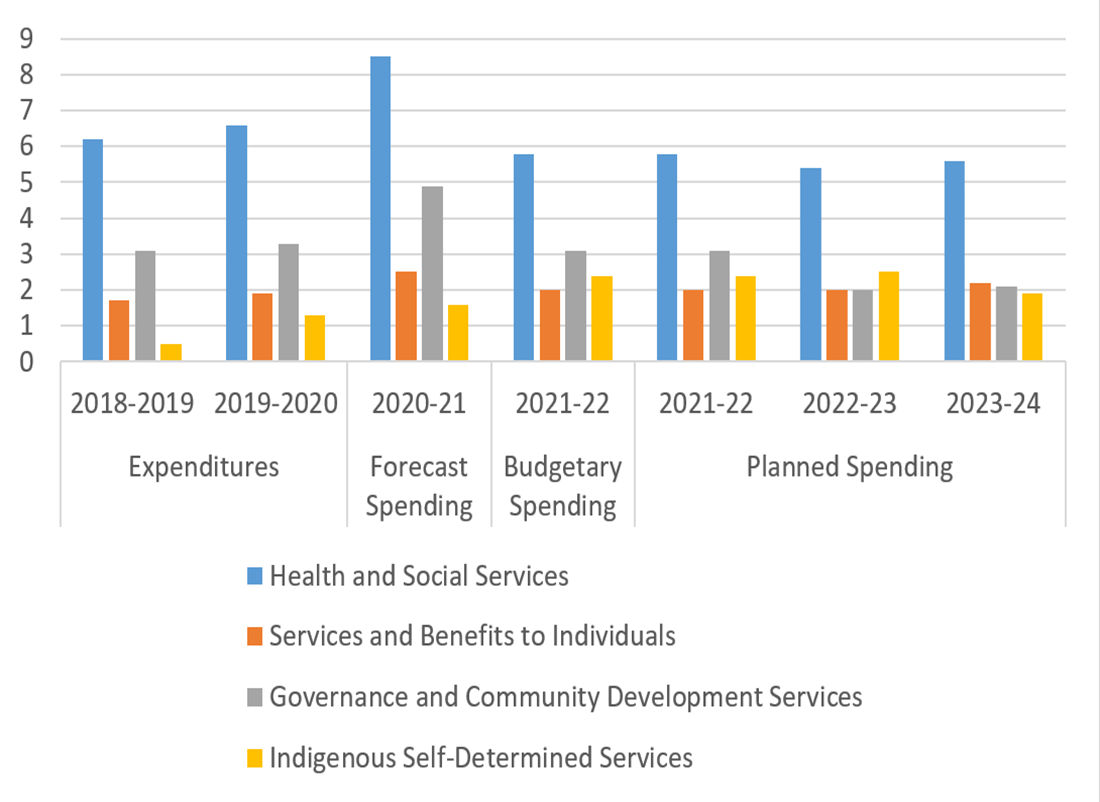
Text alternative for Figure 1: Summary of planned budgetary financial resources ($ billions)*
Bar graph showing a summary of planned budgetary financial resources in health and social services, services and benefits to individuals, governance and community development services and Indigenous self-determined services based on expenditures in fiscal years 2018-2019 and 2019-2020, forecast spending in fiscal year 2020-21, budgetary spending in fiscal year 2021-22, and planned spending in fiscal years 2022-23 and 2023-24. These data do not include internal services.
Expenditures in 2018-2019
- Health and Social Services: $6.2 billion
- Services and Benefits to Individuals $1.7 billion
- Governance and Community Development Services: $3.1 billion
- Indigenous Self-Determined Services: $0.491 billion
Expenditures in 2019-2020
- Health and Social Services: $6.6 billion
- Services and Benefits to Individuals: $1.9 billion
- Governance and Community Development Services: $3.3 billion
- Indigenous Self-Determined Services: $1.3 billion
Forecast Spending in 2020-2021
- Health and Social Services: $8.5 billion
- Services and Benefits to Individuals: $2.5 billion
- Governance and Community Development Services: $4.9 billion
- Indigenous Self-Determined Services: $1.6 billion
Budgetary Spending in 2021-2022
- Health and Social Services: $5.8 billion
- Services and Benefits to Individuals: $2 billion
- Governance and Community Development Services: $3.1 billion
- Indigenous Self-Determined Services: $2.4 billion
Planned Spending 2021-22
- Health and Social Services: $5.8 billion
- Services and Benefits to Individuals: $2 billion
- Governance and Community Development Services: $3.1 billion
- Indigenous Self-Determined Services: $2.4 billion
Planned Spending 2022-23
- Health and Social Services: $5.4 billion
- Services and Benefits to Individuals: $2 billion
- Governance and Community Development Services:: $2 billion
- Indigenous Self-Determined Services: $2.5 billion
Planned Spending 2023-24
- Health and Social Services: $5.6 billion
- Services and Benefits to Individuals: $2.2 billion
- Governance and Community Development Services: $2.1 billion
- Indigenous Self-Determined Services: $1.9 billion
*does not include Internal Services.
Budget 2021 provided a new investment of over $18B to improve the quality of life and create new opportunities for Indigenous Peoples. Examples of investments relevant to health and education include:
- $1.2B to continue supporting the COVID-19 pandemic response in Indigenous communities.
- $1.4B with $40.6M per year on-going to maintain essential health care services for First Nations and Inuit, continue work on to transform health systems and respond to the health impacts of climate change. This is addition to the government's commitment to co-develop distinctions-based Indigenous health legislation.
- $597.6M over three years for distinctions-based mental wellness strategies with First Nations, Inuit and the Métis Nation, including the renewal of the Indian Residential Health Supports Program and crisis line.
- $1.2B over five years with $181.8M on-going to ensure high quality education for First Nations children, including to ensure funding remains predictable and extend pandemic support so children on reserve can continue to attend school safely.
- $2.2B to accelerate work on the National Action Plan in response to the National Inquiry into Missing and Murdered Indigenous Women and Girls, including $126.7M to support health systems free from racism and discrimination.
- $2.5B to build on the existing distinctions-based approach to Indigenous Early Learning and Child Care.
- $100M over three years to support projects for innovative mental health interventions for populations disproportionately affected by the pandemic, including Indigenous peoples.
- $150.6M over two years to support Indigenous students and $26.4M to support Indigenous post-secondary institutions through the Post-Secondary Support Program and the Inuit and Métis Nation Post-Secondary Education Strategies in response to the impact of the pandemic.
Measuring progress will focus on two key results: 1. Quality and timely services delivered directly to Indigenous Peoples; 2. Health services delivered to Indigenous Peoples contributed to improved health outcomes. See Annex B for progress on these results.
ISC's Health and Social Services are delivered primarily in partnership with Indigenous communities and organizations, provinces/territories and agencies. Together, they focus on health and well-being for Indigenous People. They include health services to strengthen Indigenous communities in areas such as healthy living, communicable disease control, healthy child development and community care. They also include social services with an emphasis on children and families, as well as education services from kindergarten to post-secondary.
In this area, ISC will focus on three key results. See Annex B for progress on these results:
- Indigenous Peoples and communities are healthier.
- Indigenous Peoples receive social services that respond to community needs.
- Indigenous students receive an inclusive and quality education.
Health
ISC funds or directly provides health services that supplement those of the provinces and territories, including primary health care, healthy living, communicable disease control, healthy child development, community care and mental wellness. The Non-Insured Health Benefits Program provides eligible Fist Nations and Inuit clients with coverage for a range of health benefits that are not covered through other programs, plans or health insurance.
Examples of specific initiatives to note in 2021-22 include:
- continue to sustain an Indigenous-led COVID-19 response, including funding, medical supports, and prioritizing access to vaccines for Indigenous Peoples and communities by partnering with Indigenous leaders, and medical experts, provinces and territories;
- continue to implement the Nursing Recruitment and Retention Strategy and the Nursing Services Response Centre to support nurses working in Indigenous communities;
- co-develop distinctions-based health legislation with First Nation, Inuit and the Métis Nation;
- take concrete actions to address anti-Indigenous racism in healthcare in a way informed by the lived experiences and culture of Indigenous Peoples and support work to advance Joyce's Principle;
- continue to support distinctions-based approaches to Indigenous mental wellness;
- make it easier for First Nations and Inuit individuals to access the medical benefits to which they are entitled; and
- develop and implement of distinctions-based strategies to reduce commercial tobacco use.
Education
In 2021–22, ISC will continue to build upon the co-developed policy and funding approach which supports First Nations education though predictable base funding that is more directly comparable to what students enrolled in provincial education systems receive. It also includes additional funding for language and culture and full day kindergarten. The department will also continue to take steps to confirm that Indigenous post-secondary students have the supports they need to succeed and access skills and training opportunities. These education supports will help to support the goal of long-term socio-economic well-being of Indigenous families, allowing Indigenous youth to grow and learn in ways that are relevant to their unique cultures and traditions, and will help them to fully benefit from future opportunities.
Examples of specific initiatives to note in 2021-22:
- establish and implement components of a Canada-wide early learning and childcare system that reaches school-aged children on reserve;
- development and implementation of regional education agreements that respect First Nations control over First Nations education;
- continue to build on the success and lessons learned from the co-developed policy framework for First Nations elementary and secondary education on reserve;
- continue to implement timely emergency funding to support safe First Nations elementary and secondary education during the pandemic; and
- continue to implement co-developed, distinctions-based education strategies for First Nations, Inuit and Métis Nation students.
CONSIDERATIONS
- Education and health are key factors for building healthier Indigenous families, communities and populations that are also strongly interlinked. They also influenced and are influenced by other determinants of health such as culture, language, access to services, self-determination, intergenerational trauma, housing, food security among others.
- Roles and responsibilities within Canada's health care system are divided across federal, provincial and territorial governments. Provinces and territories have primary jurisdiction over the administration and delivery of health care services. For Indigenous populations, federal, provincial and territorial governments share some degree of jurisdiction.
- ISC aligns with the following guiding principles in pursuing its goals: co-development with Indigenous partners; distinctions-based recognition; substantive equality. Its five key interconnected areas are: children and families; education; health; infrastructure; and economic prosperity.
- The pandemic is having a significant impact on the health and well-being of Indigenous Peoples. Investments for the COVID-19 pandemic response have supported community-led responses to the pandemic, and providing targeted increases in primary health care resources for First Nation communities. This includes additional surge nursing capacity in remote and isolated First Nation communities where Canada is responsible for the provision of primary care, as well as public health measures to prevent the spread of COVID-19. Specifically, the efforts and investments targeted public health activities such as Personal Protective Equipment for essential workers in the community, staffing additional primary care nurses, public health nurses, paramedics and community workers, and food security to support physical isolation.
- Indigenous-led holistic approach to mental wellness are necessary to respond to the needs of youth, families and elders during the pandemic. Prior to the pandemic, demand for counselling and mental wellness support was already trending upward (see Figure 2 for an example of growing demand for mental wellness services). The COVID-19 pandemic has intensified the need for mental health support, and innovative solutions, which are particularly needed now. In August 2020, an investment of $82.5 million in mental health and wellness supports was announced to help Indigenous communities adapt and expand mental wellness services, improving access and addressing growing demand, in the context of the COVID-19 pandemic.
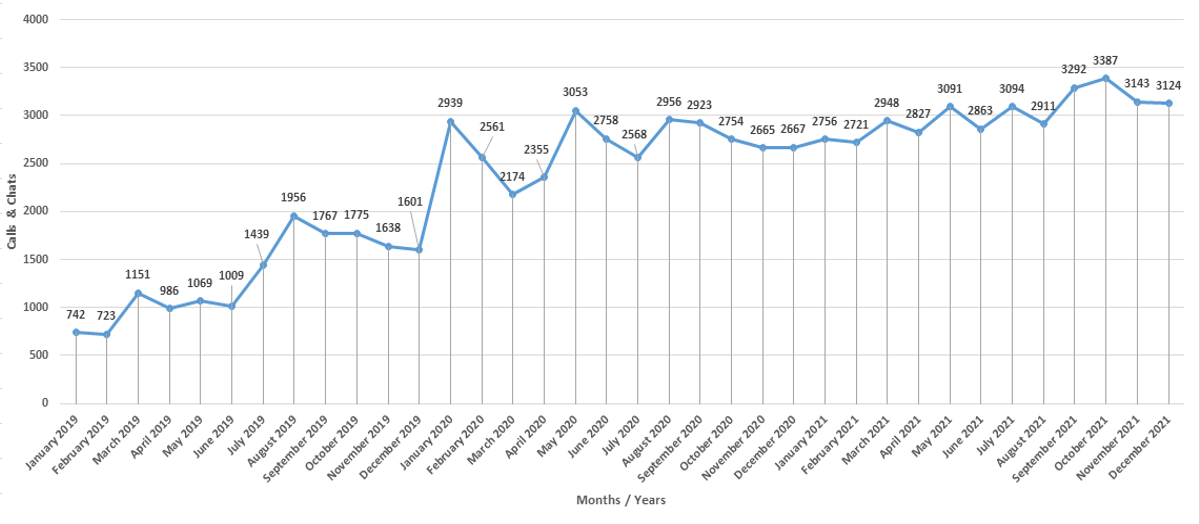
Text alternative for Figure 2: Trends over time for the Hope for Wellness Help Line Calls and Chats, January 2019 to April 2022 (433% increase)
Line graph showing trends over time for the Hope for Wellness Help Line in terms of total calls and chats received per month from January 2019 to April 2022.
January 2019: 742
February 2019: 723
March 2019: 1151
April 2019: 986
May 2019: 1069
June 2019: 1009
July 2019: 1439
August 2019: 1956
September 2019: 1767
October 2019: 1775
November 2019: 1638
December 2019: 1601
January 2020: 2939
February 2020: 2561
March 2020: 2174
April 2020: 2355
May 2020: 3053
June 2020: 2758
July 2020: 2568
August 2020: 2956
September 2020: 2923
October 2020: 2754
November 2020: 2665
December 2020: 2667
January 2021:2756
February 2021: 2721
March 2021: 2948
April 2021: 2827
May 2021: 3091
June 2021: 2863
July 2021: 3094
August 2021: 2911
September 2021: 3292
October 2021: 3387
November 2021: 3143
December 2021: 3124
January 2022: 3421
February 2022: 3356
March 2022: 3924
April 2022: 3953
ANNEXES
Annex A: A Snapshot of Current Health and Educational Outcomes for Indigenous Populations
This snapshot is a brief overview of selected indicators on health and education in Indigenous populations and should not be considered a comprehensive or exhaustive review or analysis.
Health:
| Outcome | Adults | Youth | Children |
|---|---|---|---|
| % reporting at least one diagnosed chronic health condition | 60% | 33% | 29% |
| % reporting self-rated mental health as very good or excellent | 51% | 56% | Not measured |
| % reporting symptoms suggesting likely moderate or severe mental health disorder | 43% | 23% | Not measured |
| First Nations | Métis | Inuit | |
|---|---|---|---|
| % reporting excellent or very good health | 46% | 50% | 42% |
| % reporting excellent or very good mental health | 51% | 56% | 46% |
| % reporting they had ever seriously contemplated suicide | 20% | 17% | 22% |
| % reporting having a regular medical doctor | 80% | 83% | 34% |
| % reporting contact with health professional at least once in previous year | 73% | 75% | 67% |
| % reporting health care required but not received in previous year | 15% | 14% | 16% |
|
Access to health care:
|
|||
Education:
Select indicators on education from the Census, 2016Footnote 9
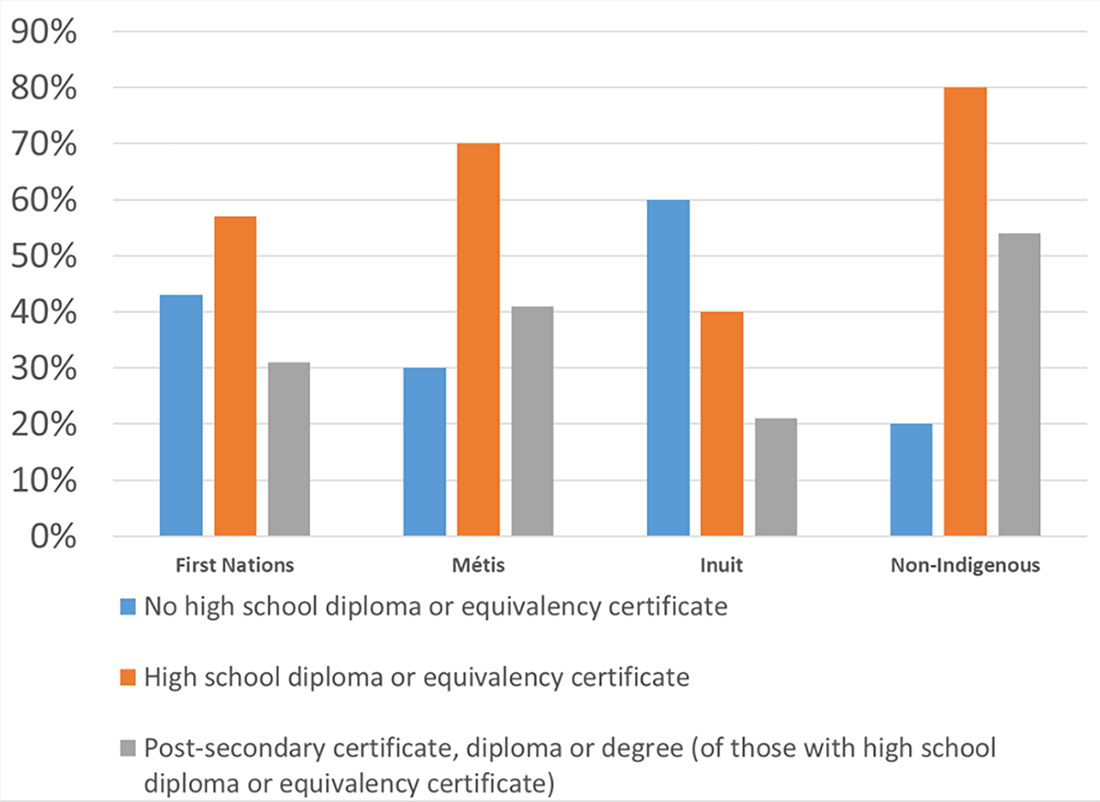
Text alternative for: Educational attainment among Canadians aged 15 years and older, 2016
Bar graph showing educational attainment among Canadians aged 15 years and older in 2016 in percentages. This graph provides data on First Nations, Métis, Inuit and Non-Indigenous populations. Educational attainment is divided into three groups for each population, namely no high school diploma or equivalency certificate, high school diploma or equivalency certificate and post-secondary certificate, diploma, degree (of those with high school diploma or equivalency certificate).
First Nations
- No high school diploma or equivalency certificate: 43.2%
- High school diploma or equivalency certificate: 56.8%
- Post-secondary certificate, diploma or degree (of those with high school diploma or equivalency certificate): 31.5%
Métis
- No high school diploma or equivalency certificate: 29.7%
- High school diploma or equivalency certificate: 70.3%
- Post-secondary certificate, diploma or degree (of those with high school diploma or equivalency certificate): 42%
Inuit
- No high school diploma or equivalency certificate: 60%
- High school diploma or equivalency certificate: 40.2%
- Post-secondary certificate, diploma or degree (of those with high school diploma or equivalency certificate): 20.7%
Non-Indigenous
- No high school diploma or equivalency certificate: 20%
- High school diploma or equivalency certificate: 80%
- Post-secondary certificate, diploma or degree (of those with high school diploma or equivalency certificate): 53.6%
Select indicators for First Nations living on-reserve and in communities, First Nations Information Governance Centre: First Nations Regional Early Childhood, Education and Employment Survey, 2016 Footnote 10
- 53% of First Nations youth participate in cultural activities outside of class time.
- 78% thought traditional teachings are very important.
- 83% of First Nations youth report some knowledge of a First Nations language.
- Among 16% of First Nations youth who had dropped out of school, 73% returned.
- First Nations youth who report parental involvement and a school that is supportive of First Nations culture were more likely to report they felt happy at school.
Annex B: Measuring Progress
Measuring progress on ISC's key priority areas
Figure 4: Progress on quality and timely services delivered directly to Indigenous people
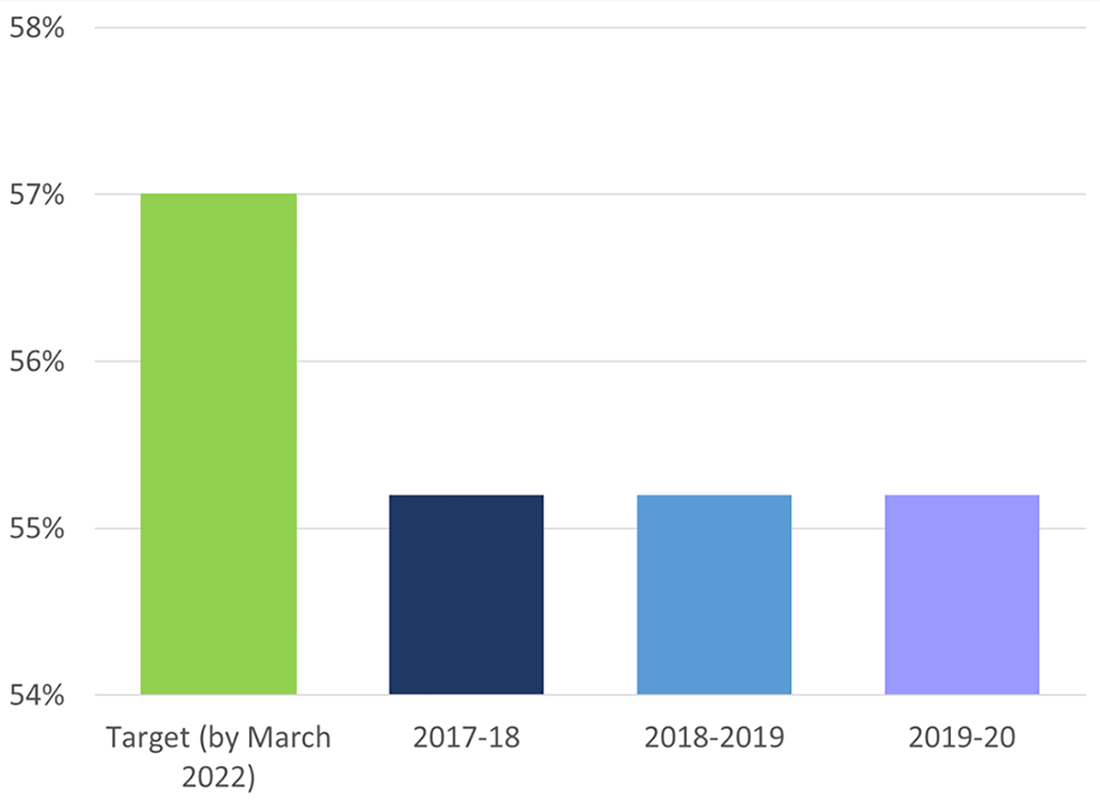
Text alternative for Figure 1: Percentage of First Nations adults who rate the quality of health care services delivered in their community as good or excellent.
Bar graph showing the percentage of First Nations adults who rate the quality of health care services delivered in their community as good or excellent. Data are represented in four categories, namely the target for this indicator to be reached by March 2022 and percentages in fiscal years 2017-18, 2018-19 and 2019-20.
- Target: 57%
- 2017-18: 55.2%
- 2018-2019: 55.2%
- 2019-20: 55.2%
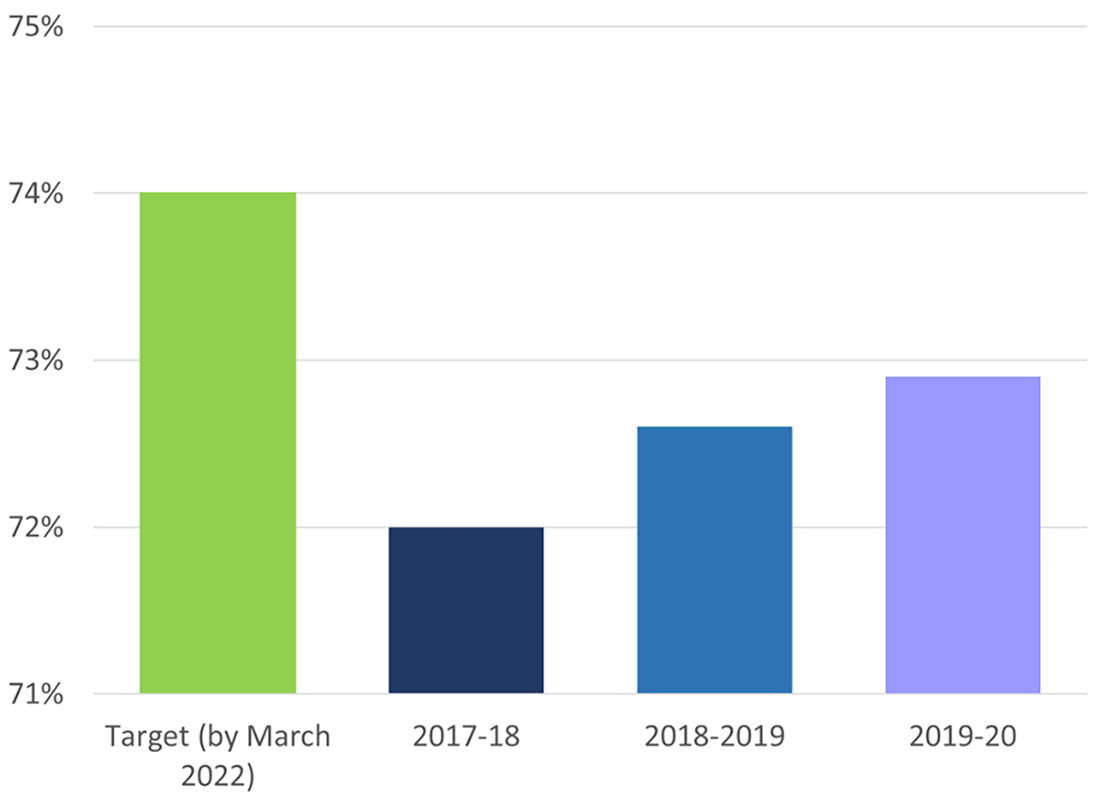
Text alternative for Figure 4b: Percentage of eligible First Nations and Inuit who received at least one non-insured health benefit in a year
Bar graph showing the percentage of First Nations adults who rate the quality of health care services delivered in their community as good or excellent. Data are represented in four categories, namely the target for this indicator to be reached by March 2022 and percentages in fiscal years 2017-18, 2018-19 and 2019-20.
- Target: 74%
- 2017-18: 72%
- 2018-2019: 72.6%
- 2019-20: 72.9%
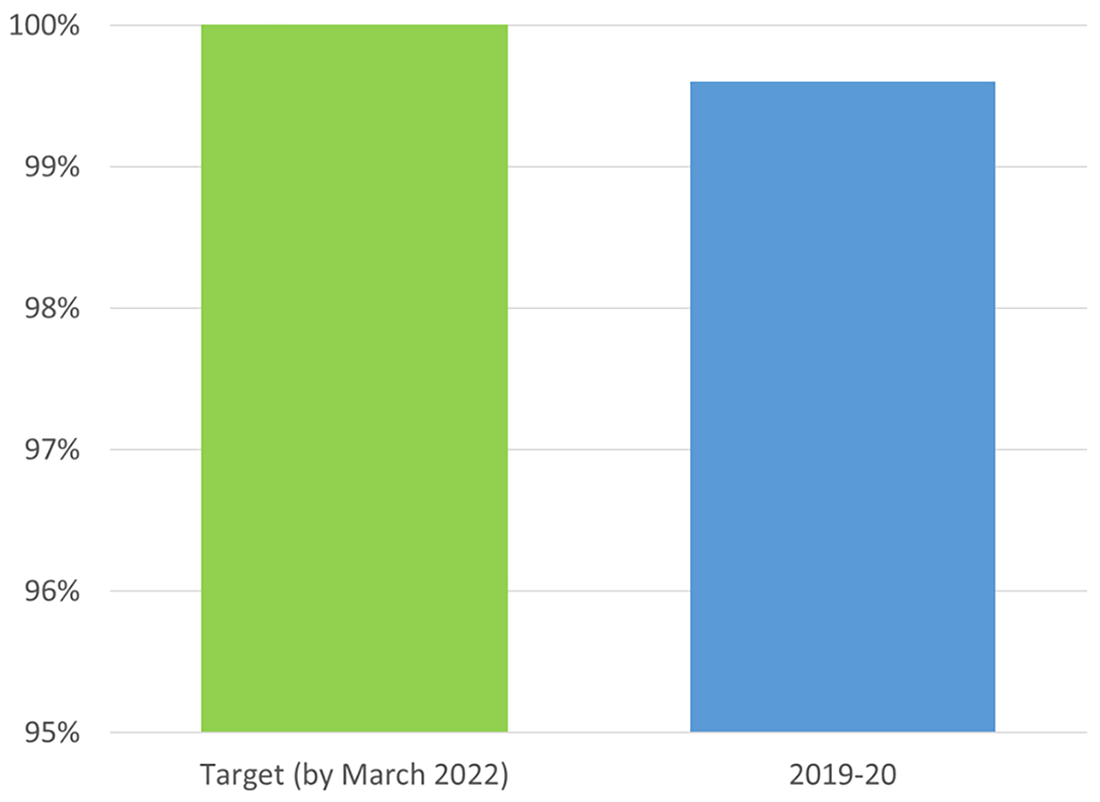
Text alternative for Figure 4c: Percentage of prior approval requests for medication coverage completed within 24 hours
Bar graph showing the percentage of prior approval requests for medication coverage completed within 24 hours. Data are represented in two categories, namely the target for this indicator to be reached by March 2022 and percentage in fiscal year 2019-20.
- Target: 100%
- 2017-18: 99.6%
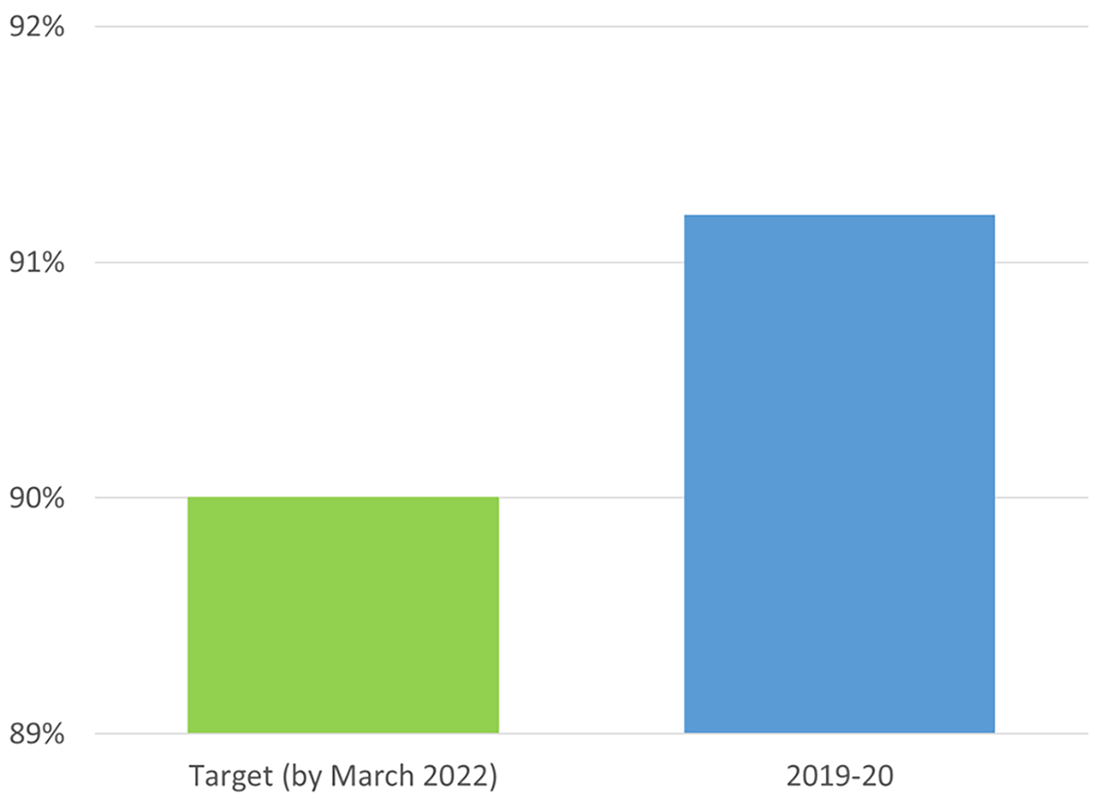
Text alternative for Figure 4d: Percentage of eligible applicants issued a Secure Certificate of Indian Status within 16 weeks from the application date
Bar graph showing the percentage of eligible applicants issued a Secure Certificate of Indian Status within 16 weeks from the application date. Data are represented in two categories, namely the target for this indicator to be reached by March 2022 and percentage in fiscal year 2019-20.
- Target: 90%
- 2017-18: 91.26%
Percentage of First Nations and Inuit adults who reported being in very good or excellent health.
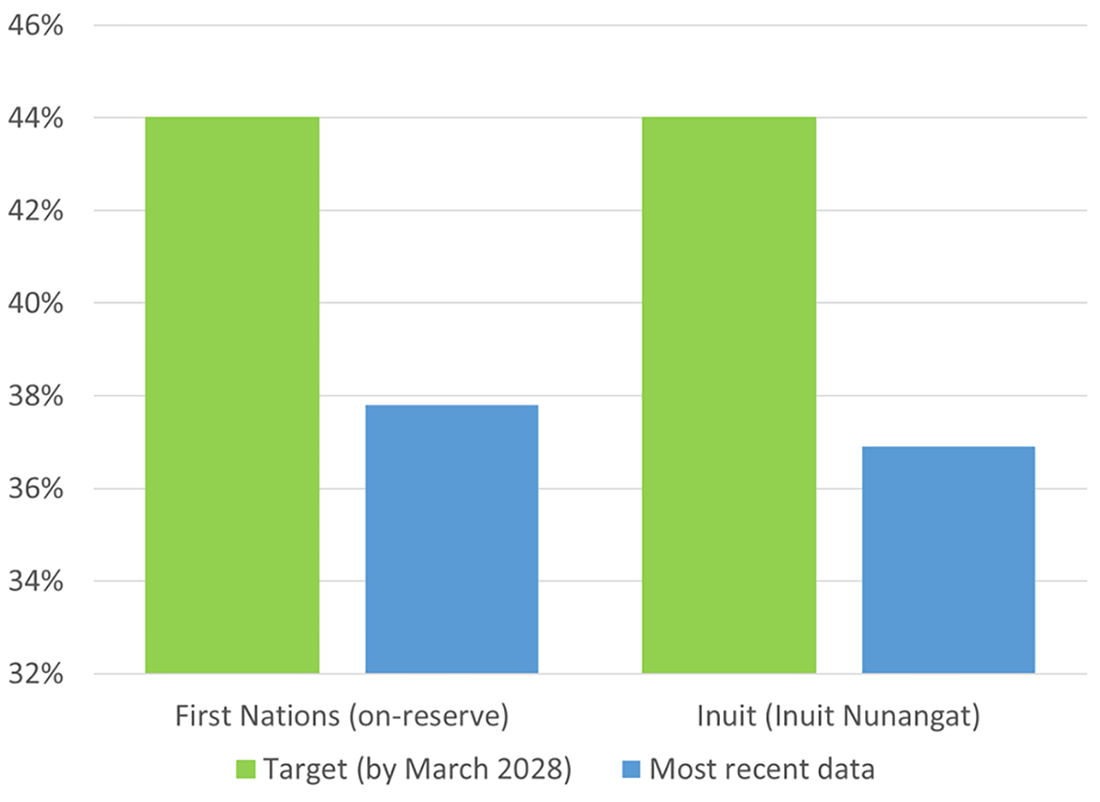
Text alternative for Figure 5: Progress on health services delivered to Indigenous Peoples contributed to improved health outcomes
Bar graph showing the percentage of First Nations on-reserve and Inuit living in Inuit Nunangat who reported being in very good or excellent health. Data are represented in two categories for First Nations and Inuit, namely the target for this indicator to be reached by March 2028 and percentages based on the most recent data.
- Target: 44%
- 2017-18: 37.8%
Inuit
- Target: 44%
- 2017-18: 36.9%
| Result | Indicator | Target | Date to achieve target | 2017–18 actual result | 2018–19 actual result | 2019–20 actual result | 2020–21 actual result |
|---|---|---|---|---|---|---|---|
| Indigenous Peoples and communities are healthier | Active tuberculosis incidence rate among Inuit living in Inuit Nunangat (threeyear average of cases per 100,000 population) | Three-year average of 0 cases per 100,000 population | March 2030 | Not applicable1 | Not applicable1 | 200 (2015–
2017) 189.9 (2014– 2016) 181.3 (2013– 2015)2 |
211.2 (2016- 2018) |
| Active tuberculosis incidence rate among First Nations on reserve (threeyear average of cases per 100,000 population) | Three-year average of 22 cases per 100,000 population | March 2028 | Not applicable1 | Not applicable1 | 26.3 (2015–
2017) 26.5 (2014– 2016) 26.7 (2013– 2015)2 |
24.3 (2016- 2018) | |
| Rate of newly reported cases of HIV among First Nations (three-year average of cases per 100,000 population) | Three-year average of 19 cases per 100,000 population | March 2028 | Not applicable1 | Not applicable1 | 14.7 (2016– 2018) 13.4 (2015– 2017) 13.1 (2014– 2016)3 |
13.7 (2017- 2019) | |
| % of First Nations adults with diabetes accessing newer, novel medications and not on insulin | 30% | March 2023 | Not applicable1 | Not applicable1 | 24.5% | 29.8% | |
| Indigenous Peoples receive social services that respond to community needs | % of First Nations and Inuit communities with access to mental wellness team services | 50% | March 2022 | 47% | 50% | 50% | |
| % of First Nations communities offering family support services aimed at keeping families together | tbd4 | tbd4 | Not applicable1 | Not applicable1 | 51% | ||
| % of First Nations children on reserve in care | tbd5 | tbd5 | 6% | 5.77% | Not available6 | ||
| % of residents living on reserve who are supported through Income Assistance | tbd7 | tbd7 | Not applicable | 27.70% | Not applicable8 | ||
| # of individuals who received services under Urban Programming for Indigenous Peoples | tbd4 | tbd | Not applicable1 | Not applicable1 | Not applicable9 | ||
| Indigenous students receive an inclusive and quality education | # of First Nations students who are provided full-day kindergarten services in First Nations administered schools | tbd4 | tbd10 | Not applicable11 | Not applicable11 | 8,089 | |
| % of students attending First Nations administered schools who are taught at least one subject in a First Nations language | Interim target: 89– 93% Final target tbd4, 12 | tbd12 | Not applicable | 88.60% | 82%13 | ||
| % of First Nations on reserve students who graduate from secondary school | Interim target: increase percentage over time Final target tbd14 | tbd | 41% | 40.5%16 | 39.9%16 | ||
| # of funded First Nations, Inuit, Métis students who graduate with a postsecondary degree/diploma/ certificate | Interim targets: First Nations: 4,110– 4,494 Inuit: 50 Métis: TBD Final targets tbd(10, 12, 15) | March 2025 | 3,686 | 3,85216 | 3,60216 | ||
|
|||||||
Supports for Tourism
KEY FACTS
Throughout the pandemic, the Government of Canada has supported both the Indigenous Tourism Association of Canada (ITAC) as well as individual Indigenous tourism businesses.
ITAC is a national industry association that supports Indigenous tourism through:
- Product development support, tourism economic development, conferences and advisory services;
- Marketing and sales support;
- Professional development training and workshops; and,
- Industry research, statistics and information.
In 2020-21 ITAC received over $5M ($5,260,750) from Government of Canada entities (ISC, Destination Canada, several Regional Development Agencies, and Parks Canada).
In 2020-21 Indigenous tourism businesses received $62M ($62,299,300) in funding support from Government of Canada entities (ISC and several Regional Development Agencies). Of this $62M, $16M was dedicated in the form of grants up to $25,000 specifically to Indigenous tourism businesses that experienced a decrease in revenue due to COVID-19. ITAC administered the delivery of the $16M in grants to individual Indigenous tourism businesses.
There is evidence that pandemic restrictions have sharply curtailed tourism activity. A Conference Board of Canada reportFootnote 11 estimated, comparing 2021 to 2019, a 51% decline in employment in the Indigenous tourism sector's associated industries, from almost 37,000 jobs down to 18,000. It is hard to know what would have happened with no government support in response to COVID, but it seems a reasonable inference that the impacts would have been worse.
As the pandemic continues, support will be sustained.
In 2021-22 ISC alone has provided $2.9M in funding to ITAC.
In 2021-22, Innovation, Science and Economic Development (ISED) created the $500M Tourism Relief Fund, which is administered by the Regional Development Agencies. A minimum of $50M of the Tourism Relief Fund will specifically support Indigenous tourism initiatives. That means 10% of the Tourism Relief Fund is dedicated to Indigenous tourism businesses. For context, about 5% of the population of Canada self-identifies as Indigenous.
An issue did arise with the Tourism Relief Fund recognizing businesses structured as sole proprietors. ITAC, to their credit raised this issue, as many Indigenous tourism businesses are sole proprietors. The Tourism Relief Fund now treats sole proprietors as eligible for funding.
Anticipated Questions
Q. Why did ITAC complain about funding?
In April 2021 ITAC issued a news release stating ITAC was close to insolvency and the industry was at risk of collapse.
In terms of the solvency of ITAC, prior to 2021-22, ITAC had received 4 years of funding from ISC. At the start of 2021-22, there was no renewed plan for multi-year funding for ITAC, which left it deeply worried. The context of COVID is relevant. When multi-year funding started for ITAC in 2017, the long-term plan included exploring own-source revenue models. In 2021, in the midst of the pandemic, with the industry turned upside down, an own-source revenue model was not viable. $500,000 was provided to ITAC early in 2021-22 to respond to immediate need, and Budget 2021 announced a further $2.4M would be provided to ITAC, for a total of $2.9M in 2021-22. ITAC viewed this amount as insufficient to carry out its work. Additionally, the role ITAC had performed of administering $16M in grants to Indigenous tourism businesses ended in 2020-21, and they may have wished to continue that role.
The charge that the industry was at risk of collapse, was expressed as a set of concerns about government funding being too difficult to access. ITAC asserted "applications for relief programs are lengthy, rife with corporate jargon and complicated business processes, and are very challenging to navigate even for Indigenous tourism experts."
Q. In regards to tourism, did Indigenous people get equitable COVID support?
Setting aside at least 10% of the Tourism Relief Fund ($50M) to go specifically to Indigenous tourism businesses, is an indication Indigenous tourism operators are not being overlooked in COVID support.
Q. Has governmental support for Indigenous tourism during the pandemic been adequate?
To mitigate the economic damage of pandemic restrictions, the Government of Canada flowed $16M specifically to Indigenous tourism operators in 2020-21. The current Tourism Relief Fund has committed a minimum of $50M to Indigenous tourism operators. These are actions taken because the Government of Canada values Indigenous tourism and recognizes it as being able to advance key priorities: expanding the reach of economic prosperity, stewardship of the land, and reconciliation.
Federal Economic Development Agency for Northern Ontario
FedNor's transition to a standalone agency
Issue
FedNor was established as a standalone Regional Development Agency (RDA) on August 12, 2021. Stakeholders may have questions about the impact of FedNor's new agency status, and the benefits of the change for the economy of Northern Ontario.
Response
- The Federal Economic Development Agency for Northern Ontario (FedNor) is the key Government of Canada partner for regional economic development in Northern Ontario.
- First created as a federal initiative in 1987 with a mandate to assist in the expansion and diversification of the economy of Northern Ontario, FedNor was established as a standalone Regional Development Agency (RDA) on August 12, 2021.
- This transformation confirms the importance of the role of RDAs across Canada.
- It will allow the federal government to better tailor the implementation of its priorities – inclusive, sustainable and fair economic development, to the needs of Northern Ontario.
- The move also responded to a need identified by community and business leaders over the years who felt Northern Ontario needed its own regional development agency.
- While continuing to support the long-term growth of Northern Ontario's economy, FedNor – along with its partner Regional Development Agencies across Canada – is also implementing several federal measures to help businesses, organizations and communities in the region affected by the economic impacts of the COVID-19 pandemic, supporting them towards recovery.
Background
Following through on its commitment in Budget 2021, the Government of Canada announced the creation of FedNor as a standalone agency on August 10, 2021. The Federal Economic Development Agency for Northern Ontario (FedNor) was formally established through Orders in Council on August 12, 2021. FedNor previously operated as an initiative of Innovation, Science and Economic Development Canada.
As part of Canada's COVID-19 Economic Response Plan, FedNor has demonstrated its ability to quickly deliver special programs such as the Regional Relief and Recovery Fund to support businesses and organizations impacted by the pandemic.
In addition to its regular programming, FedNor is also delivering four additional programs that will inject nearly $83 million in new funding into the region over the next few years. These new programs were launched earlier this summer and include the Canada Community Revitalization Fund ($19.14 million over two years), Tourism Relief Fund ($25.3 million over two years), Jobs and Growth Fund ($26.6 million over three years) and the Aerospace Regional Recovery Initiative ($11.88 million over three years).
FedNor regular programming supporting Indigenous economic development
Issue
FedNor is making a number of investments across Northern Ontario in support of Indigenous business development and Indigenous community economic diversification
Response
- Since November 2015, the Federal Agency for Economic Development in Northern Ontario has approved over 118 projects in support of Indigenous economic development, representing more than $40.4 million in funding that has generated $57.8M and helped create or maintain over 683 jobs.
- Through its 6 community-focused business offices located across Northern Ontario, FedNor acts as a convenor, pathfinder, resource and point of contact for Indigenous clients on FedNor and other federal programs.
- FedNor also funds three Indigenous Community Futures organizations to support business development in First Nations communities and members across the region.
Supplementary response:
- There are 105 Indigenous communities in Northern Ontario. FedNor is working with these communities to build their capacity to take advantage of the economic opportunities arising from major infrastructure and industry investments bordering their traditional territories.
Background
- There are 105 First Nation communities in Northern Ontario. More than 80 percent have on-reserve populations of less than 1,000 resident members and twenty-nine are considered remote as they lack all-season access to critical public roads and utilities. They are accessible by winter road or air and are diesel dependent. Almost 16% of people in Northern Ontario self-Identify as being Indigenous In 2017, less than 4% of the SMEs in Northern Ontario were majority-owned by Indigenous peoples.
- Since November 2015, FedNor has supported 118 Indigenous economic development projects through its core programs:
- 108 Northern Ontario Development Program (NODP) projects at a value of over $35.4 million Types of projects include infrastructure upgrades and developments, feasibility studies, community diversification, strategic planning, capacity building. NODP has a 15 per cent set aside for projects benefitting underrepresented groups, including Indigenous peoples.
- 10 Community Futures Program (CFP) agreements at a value of $5 million, consisting of operational funding to support the three Aboriginal Financial Institutions that form part of the Community Futures network in Northern Ontario
Examples of projects funded by FedNor
- Indigenous business growth: In 2020, FedNor invested $272,000 (NODP) through a non-repayable contribution towards the Pikangikum Youth Sawmill Program. This project supported the ongoing work and further development of the Pikangikum Youth Sawmill Program, which provides wood products for sale, as well as essential work experience for youth, creating and maintaining 26 jobs.
- Through NODP, PLATO received $2.6 million in funding in 2018 to establish an Indigenous Software Testing Centre in Sault Ste. Marie. The Centre trains, develops and delivers software application and system testing services and solutions to private and public sector clients in Sault Ste. Marie and across the globe. The project increased the number of skilled and domestic software testers and IT professionals available in Northern Ontario, and addressed training and underemployment challenges faced by Indigenous groups across the region.
- Capacity Building: FedNor also provided Waubetek Business Development Corporation with the funding required to complete a Mining Strategy for the Indigenous communities in the region in 2018. A key component of the strategy is the Indigenous Centre of Excellence in Mining, located in Sudbury to provide Indigenous and non-Indigenous peoples with information and guidance on roles, relationships and procedures for working with Indigenous Peoples on mine-related developments.
PARLIAMENTARY AFFAIRS OFFICE
Marie-Chantale Smith, Corporate Secretariat, Office of the DM/President, (514) 235-3263
PREPARATION AND APPROVAL
Prepared by: Karen Hoeg, A/Manager Policy, Analysis and Coordination, (705) 929-3482
Sector contact: Stephanie Duhaime, Director of Policy, (249) 377-5126
Approved by: Manon Brassard, Interim President of FedNor, (249) 377-6043
Sector approval:
FedNor support to Indigenous organizations and businesses to deal with the impact of COVID-19
Issue
Through its recovery and relief programs FedNor is supporting Indigenous businesses and communities affected by the economic impacts of COVID-19 and prepare for new and emerging opportunities.
Response
- Through the Regional Relief and Recovery Fund (RRRF), over $7.3 million was invested through FedNor and partner Community Futures Development Corporations to help 81 Indigenous businesses and organizations mitigate the impacts from the COVID-19 pandemic.
- FedNor is assisting businesses and organizations to recover and reposition from the economic impacts of COVID-19 through four additional recovery programs announced as part of Budget 2021 that will inject $83 million in new funding into the region over the next few years.
- FedNor's COVID-19 recovery and relief programming offers flexible funding criteria for Indigenous communities, organizations, and businesses to maximize funding support.
Supplementary response:
- In addition to supporting vulnerable Indigenous businesses and eligible organizations impacted by COVID-19, FedNor continues to provide meaningful support to Indigenous clients in their ongoing planning, community economic development and capacity-building efforts.
Background
- The economic impacts of the COVID-19 crisis have been felt acutely by Indigenous populations in Northern Ontario. Many Indigenous communities in rural and remote areas and have struggled with the impacts of COVID-19 because they lack access to basic infrastructure such as broadband. The asymmetrical impacts of COVID-19 on Indigenous populations in Northern Ontario have led to high unemployment, including among youth, and a lack of opportunities for meaningful economic participation and economic development.
- Through the Regional Relief and Recovery Fund (RRRF), over $7.3 million was invested through FedNor and partner Community Futures Development Corporations (CFDC) to help more than 81 Northern Ontario Indigenous businesses and organizations mitigate the impacts and recover from the COVID-19 pandemic.
- FedNor now also delivers four additional recovery programs, announced as part of Budget
2021 and launched last summer, that will inject $83 million in new funding into the region
over the next few years. They are:
- the Canada Community Revitalization Fund ($19.14 million/two years),
- Tourism Relief Fund ($25.3 million/two years) with a 10 per cent set aside for Indigenous tourism projects,
- Jobs and Growth Fund ($26.6 million/three years), and
- the Aerospace Regional Recovery Initiative ($11.88 million/three years).
- To help clients maintain cash flow, FedNor also deferred payments for all clients and waived associated interest until January 1, 2021.
Examples of projects funded by FedNor
- Through RRRF, over $1.1 million was invested through FedNor and partner Aboriginal Financial Institutions in the CFDC network to help businesses and organizations in their catchment areas mitigate the impacts and recover from the COVID-19 pandemic.
PARLIAMENTARY AFFAIRS OFFICE
Marie-Chantale Smith, Corporate Secretariat, Office of the DM/President, (514) 235-3263
PREPARATION AND APPROVAL
Prepared by: Karen Hoeg, A/Manager Policy, Analysis and Coordination, (705) 929-3482
Sector contact: Stephanie Duhaime, Director of Policy, (249) 377-5126
Approved by: Manon Brassard, Interim President of FedNor, (249) 377-6043
Sector approval:
FedNor's available supports to Indigenous Businesses, Organizations and Communities including COVID-19 recovery
| Programs and Initiatives | Type of Projects | Eligible Indigenous Recipients | Key Elements | |
|---|---|---|---|---|
| Core Program- Northern Ontario |
Northern Ontario Development Program (NODP) |
Community Economic Development (CED) | First Nations communities and not- for-profit Indigenous organizations |
|
| Community Investment Initiative for Northern Ontario (CIINO) |
First Nation communities and Tribal Councils on behalf of several communities |
|
||
| Core Programs- National |
Regional Economic Growth through Innovation (REGI) |
Business Scale-up and Productivity (BSP) |
Indigenous organizations such as Indigenous-owned businesses |
|
| Regional Innovation Ecosystem (RIE) |
Indigenous organizations such as Indigenous-led not-for-profits and organizations such as First Nations as represented by their Chief and Council, Tribal Councils, Indigenous Representative Organizations, Métis and Inuit organizations, as well as Indigenous owned businesses |
|
||
| Community Futures Program (CFP) |
CFDCs and CF Includes 3 Aboriginal |
|
||
| Time- Limited Programs |
Tourism Relieve Fund (TRF) June 2021/March 2023 |
Not-for-profit organizations and SMEs |
|
|
| Jobs and Growth Fund (JGF) June 2021/March 2024 |
Not-for-profit organizations and SMEs |
|
||
| Canada Community Revitalization Fund (CCRF) |
NPO, Municipal and Indigenous Organizations |
|
FedNor support to Indigenous Procurement opportunities
Issue
Indigenous Procurement (coaching pilot and success stories)
Response
- Implementation will be phased across federal departments over 3 years starting in the 2022-23 fiscal year. Given FedNor's new departmental status, it has been placed into the 3rd phase of the PSIB and will need to meet the 5 per cent target in fiscal 2024-25.
Background
- The Procurement Strategy for Indigenous Business (PSIB) is the Government of Canada's policy to support Indigenous businesses with procurement opportunities.
- The Government of Canada is committed to increasing the participation of Indigenous businesses in federal procurement.
- Public Services and Procurement Canada is working with Indigenous Services Canada and the Treasury Board of Canada Secretariat to implement a target to have 5 per cent of federal contracts awarded to businesses managed and led by Indigenous Peoples.
- The 5 per cent target seeks to leverage government spending to help grow Indigenous businesses and improve the socio-economic conditions of Indigenous communities.
PARLIAMENTARY AFFAIRS OFFICE
Marie-Chantale Smith, Corporate Secretariat, Office of the DM/President, (514) 235-3263
PREPARATION AND APPROVAL
Prepared by: Karen Hoeg, A/Manager Policy, Analysis and Coordination, (705) 929-3482
Sector contact: Stephanie Duhaime, Director of Policy, (249) 377-5126
Approved by: Manon Brassard, Interim President of FedNor, (249) 377-6043
Sector approval:
FedNor support to Indigenous Tourism in Northern Ontario
Issue
FedNor supports Indigenous Tourism through both its core programs and its relief and recovery programs. This includes supports at the business, community and sector-wide level across the region.
Response
- FedNor invested over $701,000 through the Regional Relief and Recovery Fund (RRRF) to help Indigenous businesses and organizations in the tourism sector mitigate the economic impacts of the COVID-19 pandemic.
- FedNor will also be supporting Indigenous-owned or led projects under the Tourism Relief Fund. FedNor has a target to provide at least 10 percent of its $25 million Tourism Relief Fund budget to support Indigenous tourism.
Supplementary Response
- Through the Prosperity and Growth Strategy for Northern Ontario (PGSNO), FedNor will continue to support Indigenous tourism and business growth by bringing federal and provincial governments and the private sector together to provide the services they need to develop and grow over the long term.
Background
- Indigenous Tourism Ontario (ITO) estimated in October 2021 that nearly half of the $654 million in annual GDP impact of Indigenous tourism in the province was lost in 2020 due to the pandemic, including 4000 jobs. ITO calculates that Ontario represents approximately one third of Canada's activity in the sector.
- To support Indigenous tourism in its region, FedNor has historically worked with Aboriginal Financial Institutions, the non-profit Indigenous Tourism Ontario (ITO), regional tribal councils, and individual First Nation communities and businesses.
- FedNor has continued this strategy with the Tourism Relief Fund (TRF) announced in Budget 2021. The $500 million national program is being delivered through Regional Development Agencies (RDAs), with the exception of $15 million to be delivered through Innovation, Science and Economic Development (ISED) to support pan-Canadian national projects. As with other RDAs, FedNor is targeting at least 10 per cent of its TRF budget to Indigenous tourism.
- Established in 2015, ITAC is a non-profit organization with a national mission to support Indigenous tourism. ITAC has not been active in Northern Ontario during its existence. It has received nearly $30 million in federal support since 2017. This includes $2.5 million in funding received from RDAs in 2019 under the Canadian Experiences Fund.
- ITAC was dissatisfied with the announced level of support it received in Budget 2021 for its industry recovery efforts (approximately $2.4 million). The expectation is that ITAC will work directly with ISED to access TRF support.
- Through RRRF, FedNor delivered over $701,000 to help 6 Northern Ontario Indigenous businesses and organizations in the tourism sector mitigate the impacts and recover from the COVID-19 pandemic.
Examples of projects funded by FedNor:
In 2020 through the Canadian Experiences Fund, FedNor announced funding of $611,051 towards Wiikwemkoong Unceded Territory's Point Grondine Eco Park Development near Killarney, Ontario. This phase one development totaled more than $3 million in cost and included infrastructure and amenities to support the visitor experience, resulting in a major new Indigenous tourism product of interest to international visitors.
In 2020, also through the Canadian Experiences Fund, FedNor announced funding of $250,082 to the Indigenous Tourism Association of Canada (ITAC), in partnership with other RDAs, to support market research and brand development for ITAC's Destination Indigenous international marketing campaign.
PARLIAMENTARY AFFAIRS OFFICE
Marie-Chantale Smith, Corporate Secretariat, Office of the DM/President, (514) 235-3263
PREPARATION AND APPROVAL
Prepared by: Arik Theijsmeijer, A/Manager, (705) 665-3185
Sector contact: Lucie Perrault, Director of Program Delivery, (705) 690-7865
Approved by: Manon Brassard, Interim President of FedNor, (249) 377-6043
Biographies
INAN biographies
The Hon. Marc Garneau, Notre-Dame-de-Grâce—Westmount, QC INAN Chair

BIOGRAPHICAL INFORMATION
Born in Quebec City, Quebec, the Honourable Marc Garneau was first elected to the House of Commons in 2008, and re-elected in 2011, 2015, 2019, and 2021.
Mr. Garneau graduated from the Royal Military College of Canada in 1970 with a Bachelor of Science in engineering physics and began his career in the Canadian Forces Maritime Command. In 1973 he received a PhD in electrical engineering from the Imperial College of Science and Technology in London, England.
From 1982 to 1983, he attended the Canadian Forces Command and Staff College in Toronto. While there, he was promoted to the rank of commander and was subsequently promoted to captain(N). Mr. Garneau retired from the Canadian Forces in 1989.
Mr. Garneau was also one of the first six Canadian Astronauts and he became the first Canadian in outer space in October 1984. In February 2001, he was appointed executive vice-president of the Canadian Space Agency and became its president in November 2001.
Mr. Garneau was Minister of Transport from 2015-2021 and Minister of Foreign Affairs January-October 2021 . Mr. Garneau is currently not in Cabinet.
Jamie Schmale, Haliburton—Kawartha Lakes—Brock, ON
Critic for Indigenous Services; Vice-Chair INAN

BIOGRAPHICAL INFORMATION
Born in Brampton, ON, Jamie Schmale was elected to the House of Commons for the first time in 2015, and re-elected in 2019 and 2021.
Prior to his election, Mr. Schmale served as the executive assistant and campaign manager for former Conservative MP Barry Devolin (Haliburton-Kawartha Lakes-Brock, Ontario). He graduated from the Radio Broadcasting program at Loyalist College in Ontario and started his career as a news anchor. He later became a news director for CHUM media.
Mr. Schmale was the critic for Crown-Indigenous Relations in the 43rd Parliament. In the 42nd Parliament, Mr. Schmale served as the opposition critic for Northern Economic Development, and Deputy Critic for Natural Resources. He was a member of the Standing Committee on Procedure and House Affairs (2015-2017) and the Standing Committee on Natural Resources (2017-2019).
Currently, Mr. Schmale serves as the critic for Indigenous Services.
Marilène Gill, Manicouagan, QC Critic Indigenous and Northern Affairs; Vice-Chair INAN

BIOGRAPHICAL INFORMATION
Born in Sorel, QC, Marilène Gill was first elected to the House of Commons in 2015, and was re-elected in 2019 and 2021.
Prior to her election, Mrs. Gill was teaching at the college level and pursuing doctoral studies in literature. Her background also includes roles as a unionist, development officer, coordinator of the Table de concertation en condition feminine de la Côte-Nord. She is also involved in the Conseil des arts et des lettres du Québec (CALQ). She has also acted as literary director for Éditions Trois-Pistoles, and has published personal works there for which she has received several awards and grants. Mrs. Gill was also political attaché to Michel Guimond, former member and chief whip of the Bloc Québécois.
Mrs. Gill is deputy whip, chair of the Young Families Caucus and critic for Indigenous and Northern Affairs for the Bloc Québécois.
Jenica Atwin, Fredericton, NB

BIOGRAPHICAL INFORMATION
Jenica Atwin grew up in Oromocto, NB. She was first elected to the House of Commons in 2019 as a Member of the Green Party before joining the Liberal Party in June 2021.
Mrs. Atwin completed a Master's in Education at the University of New Brunswick.
Prior to being elected, she was an education consultant and researcher at a First Nations Education Centre. In 2016, she co-organized a spin-off of We Day focused on introducing First Nations youth to one another and helping those who have recently moved off of reserves.
She is a new member of INAN. She previously served on the COVID-19 Pandemic Committee.
Jaime Battiste, Sydney—Victoria, NS Parliamentary Secretary to the Minister of Crown-Indigenous Relations

BIOGRAPHICAL INFORMATION
Born on the Eskasoni First Nation, NS, Jaime Battiste was elected to the House of Commons in 2019 and re-elected in 2021. He is the first Mi'kmaw Member of Parliament in Canada.
Mr. Battiste graduated from Schulich School of Law at Dalhousie University in 2004. He has held positions as a Professor, Senior Advisor, Citizenship Coordinator, and as a Regional Chief for the Assembly of First Nations.
Mr. Battiste's volunteer work over the years involves athletics, youth advocacy, community events, and advocacy for the Mi'kmaq Nation. He is a member of the Aboriginal Sport Circle and a part owner of the Eskasoni Junior B Eagles.
Mr. Battiste served as a representative to the Assembly of First Nation's National Youth Council from 2001-2006. In 2005, the National Aboriginal Healing Organization named him as one of the "National Aboriginal Role Models in Canada." In 2006, as the Chair of the Assembly of First Nations Youth Council, he was one of the founding members of the Mi'kmaw Maliseet Atlantic Youth Council (MMAYC), an organization that represents and advocates for Mi'kmaw and Maliseet youth within the Atlantic region. In 2018, Mr. Battiste was recognized with the Sovereign's Medal for Volunteers, which is a Canadian decoration to honour volunteers who have made significant and continual contributions to their community.
Mr. Battiste was named Parliamentary Secretary to the Minister of Crown-Indigenous Relations in December 2021.
He has been a member of INAN since February 2020 and has previously been a member of the Standing Committee on Fisheries and Oceans.
Michael V. Mcleod, Northwest Territories, NWT

BIOGRAPHICAL INFORMATION
Born in Fort Providence, NWT, Michael Mcleod was first elected to the House of Commons in 2015 and re-elected in 2019 and 2021.
Prior to entering federal politics, Mr. McLeod served Northwest Territories residents as a member of the Legislative Assembly from 1999-2011 and advised clients in the tourism industry as Tourism Development Officer for the Government of the Northwest Territories. He also previously served as mayor of Fort Providence, president of his Métis Local, and vice-president of Deh Cho Regional Council.
Mr. McLeod earned a diploma in Management Studies from Arctic College and began his career as a self-employed contractor. He has been a member of the Northwest Territories Tourism, NWT Public Utilities, and Mackenzie Valley Environment Impact Review Boards. The latter's mission, conducting fair and timely environmental assessments, remains a key interest.
Mr. McLeod was previously a member of INAN 2016-2017 and has served as a member of the Standing Committee on Finance and as Chair of the Arctic and Northern Caucus.
Marcus Powlowski, Thunder Bay—Rainy River, ON

BIOGRAPHICAL INFORMATION
Born in Fort William, ON, Marcus Powlowski was first elected to the House of Commons in 2019 and re-elected in 2021.
Prior to being elected, Mr. Powlowski served as a physician in the Emergency Room at Thunder Bay Regional Health Science Centre. In addition to being a medical doctor, he has two law degrees - LL.B, LL.M from the universities of Toronto and Georgetown, respectively. He also attended Harvard University and obtained a Masters of Public Health in Health Law and Policy.
Mr. Powlowski worked as a doctor for two years in northern First Nations communities, and for seven years practicing medicine in several developing countries in Africa and Oceania. For several years, he worked as a consultant in health legislation for the World Health Organization. He also volunteered on a medical project in Ethiopia.
Mr. Powlowski has been a member of INAN since February 2020 and has also sat on the COVID-19 Pandemic Committee and the Standing Committee on Health.
Patrick Weiler, West Vancouver—Sunshine Coast—Sea to Sky Country, BC

BIOGRAPHICAL INFORMATION
Born in West Vancouver, BC, Patrick Weiler was first elected to Parliament in 2019 and re-elected in 2021.
Prior to his election, Mr. Weiler was an advocate for safeguarding the environment as an environmental and natural resource management lawyer, representing First Nations, small businesses, municipalities, and non-profit organizations in Canada and internationally. Mr. Weiler has also worked in partnership with the United Nations and international development agencies, with a mission to improve the governance of natural resources and management of aquatic ecosystems.
Mr. Weiler completed a Bachelor of Arts at McGill University and received his Juris Doctor degree from the University of British Columbia's Faculty of Law.
Mr. Weiler served on the Standing Committee on Natural Resources, the Standing Committee on Government Operations and Estimates, and the bi-partisan Climate Caucus and Tourism Caucus.
Martin Shields, Bow River, AB Deputy Critic Minister for Indigenous Services
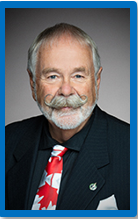
BIOGRAPHICAL INFORMATION
Born in Lethbridge, AB, Martin Shields was first elected to the House of Commons in 2015, and reelected in 2019 and 2021.
Prior to his election to the House of Commons, Mr. Shields served as a teacher and administrator for 30 years and a part-time university instructor for 20 years. He has served as Mayor and Councilor of the City of Brooks, Board member and vice chair of the Palliser Regional Health Board, Shortgrass Regional Library, Alberta Provincial Library Trustees Association, Bow River Basin Council, as well as a Director and Vice President of the Alberta Urban Municipalities Association.
He has previously served as the Director of Strathmore-Brooks Alberta Conservative Constituency Association and is a past President of the Medicine Hat Federal Conservative Constituency Association.
He has served on several committees, including the Standing Committee on Environment and Sustainable Development, Standing Committee on Canadian Heritage, and the Standing Committee on the Status of Women. He also served as vice chair of the CPC-Alberta MP Caucus.
Mr. Shields is currently the CPC deputy critic for Indigenous Services.
Shannon Stubbs, Lakeland, AB

BIOGRAPHICAL INFORMATION
Born in Chipman, AB, Shannon Stubbs was first elected to Parliament in 2015, and re-elected in 2019 and 2021.
Prior to her election, she worked for several years in the Oil Sands Business Unit in the Alberta Department of Energy and in the International Offices and Trade Division of Alberta Economic Development. She was then a Senior Consultant with Hill + Knowlton Canada where she advocated for clients across the health and pharmaceutical, oil and gas, not for profit and charity, and education sectors. She also contributed to a successful initiative for the expansion of energy trades and technology education and apprenticeship training with Government and Community Relations at SAIT Polytechnic.
Mrs. Stubbs is a new member of INAN. She previously served as the Critic for Public Safety and Emergency Preparedness, and as Critic for Natural Resources. She was the Vice Chair of the Standing Committees on Public Safety and National Security, Natural Resources, and the Special Select Standing Committee for Pay Equity.
Gary Vidal, Desnethé—Missinippi—Churchill River, SK Critic for Crown-Indigenous Relations

BIOGRAPHICAL INFORMATION
Born in Meadow Lake, SK, Gary Vidal was elected to the House of Commons for the first time in 2019 and re-elected in 2021.
Prior to his election, Mr. Vidal served as Mayor of Meadow Lake, Saskatchewan from 2011 to 2019. He studied at the University of Saskatchewan and Briercrest Bible College. He is a Chartered Professional Accountant (CPA, CGA) and is a partner in the accounting firm Pliska Vidal & Co. since 1988. He was also Vice Chair of Saskatchewan City Mayors' Caucus from 2016 to 2018. He was a member of the SaskWater Board of Directors from 2008 to 2017. In this position, he also served as Chair of the Governance and Corporate Responsibility Committee, Chair of the Audit and Finance Committee, and Chair of the Board from 2015 to 2017.
Mr. Vidal has volunteered in a variety of leadership capacities in his local church as well as on the board of Bethel Gospel Camp, an interdenominational children's bible camp. Other volunteer activities include coaching and managing minor hockey, baseball, and soccer teams. In 2012, he was awarded the Queen Elizabeth II Diamond Jubilee Medal.
Mr. Vidal previously served as the critic for Indigenous Services, and is currently the critic for Crown-Indigenous Relations. He has been a member of INAN since February 2020 and also sat on the Special Committee on the COVID-19 Pandemic during the last Parliament (2019-2021).
Lori Idlout, Nunavut, NV Critic – Northern Affairs; Critic – Indigenous Services; Critic – Crown-Indigenous Relations
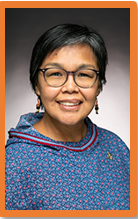
BIOGRAPHICAL INFORMATION
Born in Igloolik, NU, Lori Idlout was first elected to the House of Commons in 2021.
Prior to her election Ms. Idlout practiced law in Iqaluit with her own firm, Qusugaq Law. She represented the group protesting against the Baffinland Iron Mine's expansion, as well as serving as the technical adviser for the Ikajutit Hunters and Trappers Organization during a public hearing on the issue. Between 2004 and 2011, Ms. Idlout served as the executive director of the Nunavut Embrace Life Council, a not-for-profit organization committed to suicide prevention. She had previously worked for Nunavut's Department of Health and Nunavut Tunngavik Incorporated as a policy analyst, and was the founder of Coalition of Nunavut DEAs as a director of the Iqaluit District Education Authority in order to advocate for educational services.
Ms. Idlout received a bachelor's degree in psychology from Lakehead University in 1997, and a doctorate in law from the University of Ottawa (2018).
She is a new member of INAN and the NDP critic for Crown-Indigenous Relations and Northern Affairs, and Indigenous Services.